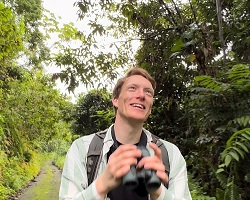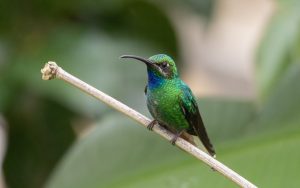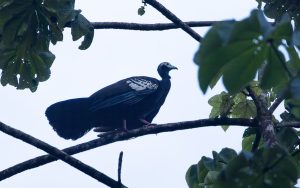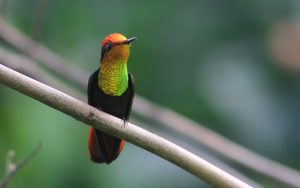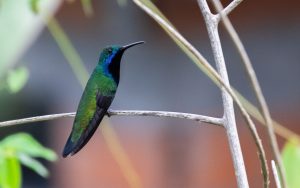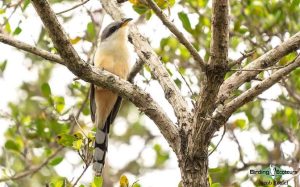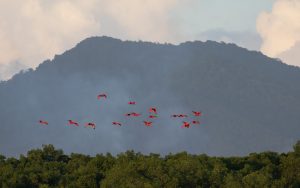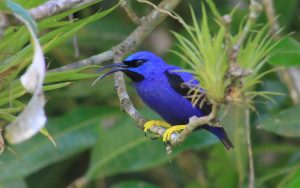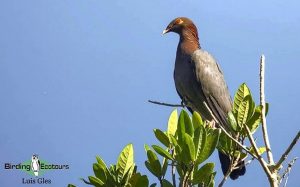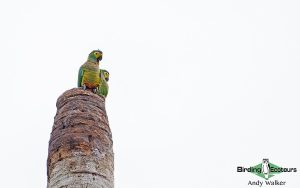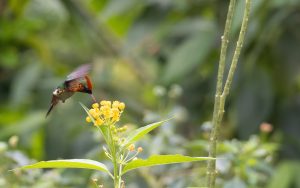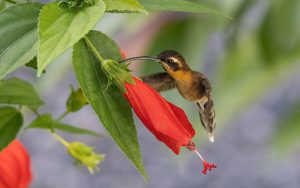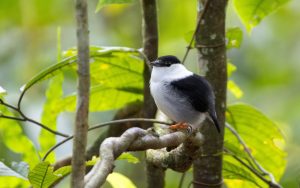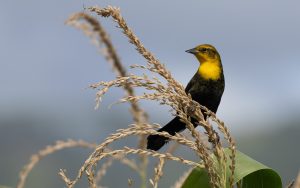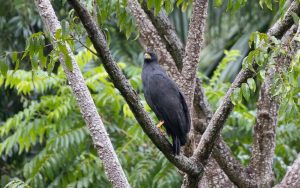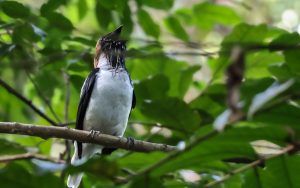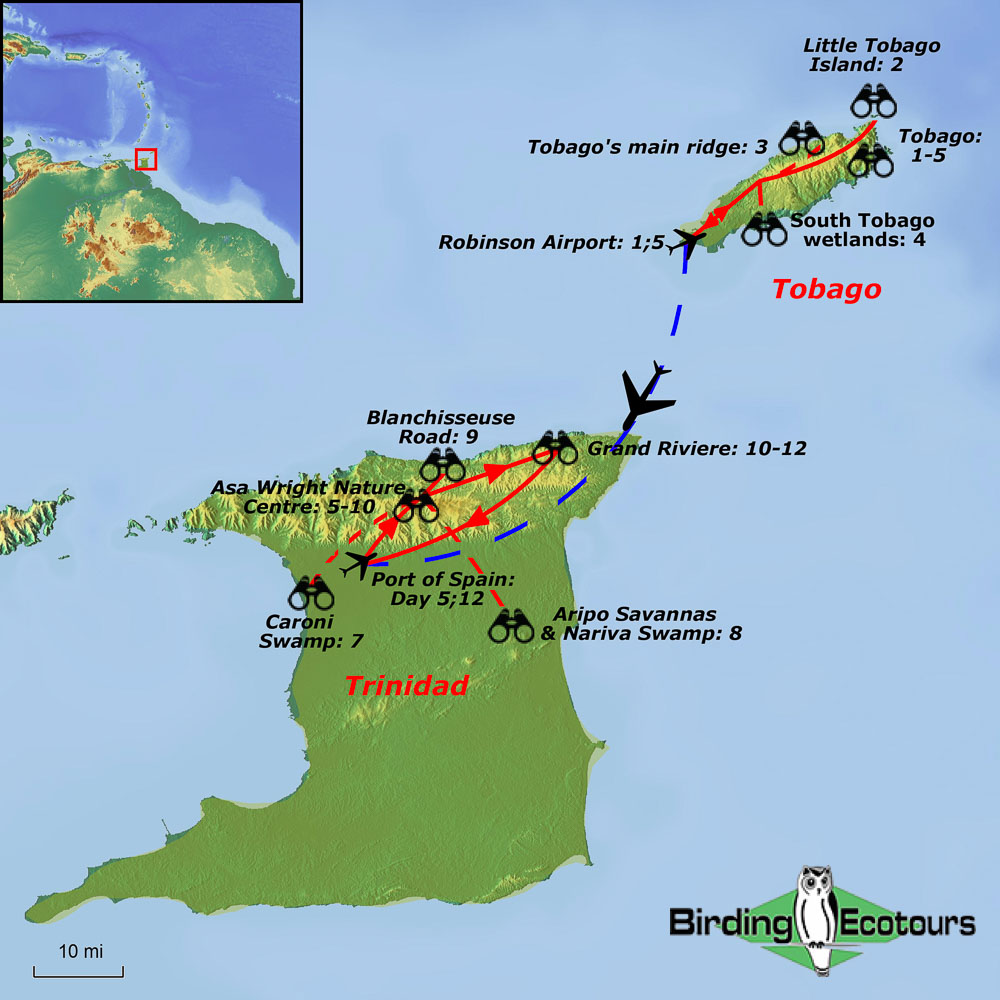Trinidad and Tobago Birding Tour: An Introduction to Neotropical Birding
Trinidad and Tobago Birding Tour: An Introduction to Neotropical Birding
November 2026
For their small size of less than 2,000 square miles (~5,100 square kilometers), the tiny isles of Trinidad and Tobago host a staggeringly high diversity of bird species, with more than 500 species recorded. Situated just seven miles (11 km) north of Venezuela and the South American mainland, the biodiversity of the twin isles is comprised of a blend of both Amazonian and West Indies wildlife, which makes this a unique birdwatching destination.
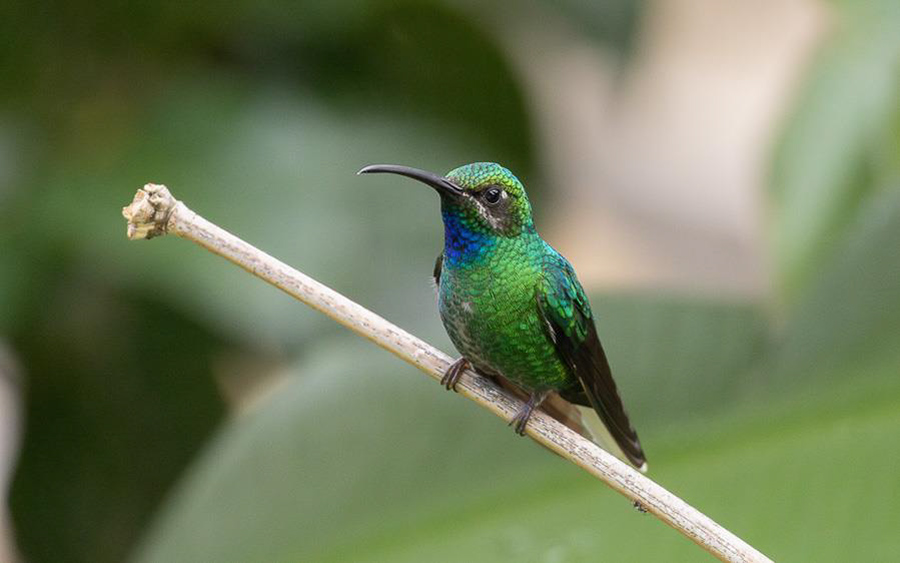 The beautiful near-endemic White-tailed Sabrewing is a major target on this tour (photo Fraser Bell).
The beautiful near-endemic White-tailed Sabrewing is a major target on this tour (photo Fraser Bell).
Our tour starts on Tobago, which has a distinctly more Caribbean flavor and is even more picturesque than its larger neighbor, with lush, forested heights sloping gently into beautiful tropical beaches, surrounded by diverse coral reefs. Here we will seek species that are not found on Trinidad, which include the localized White-tailed Sabrewing, found only here or on the Paria Peninsula in Venezuela. Despite its name, the endemic Trinidad Motmot is much more abundant on Tobago, as is Rufous-tailed Jacamar. After taking a glass-bottom boat trip to Little Tobago Island to get up close with some spectacular seabirds which nest on the island, such as beautiful Red-billed Tropicbirds. We then bird our way across Tobago, exploring its wetlands and forests for specials such as Blue-backed Manakin and Venezuelan Flycatcher.
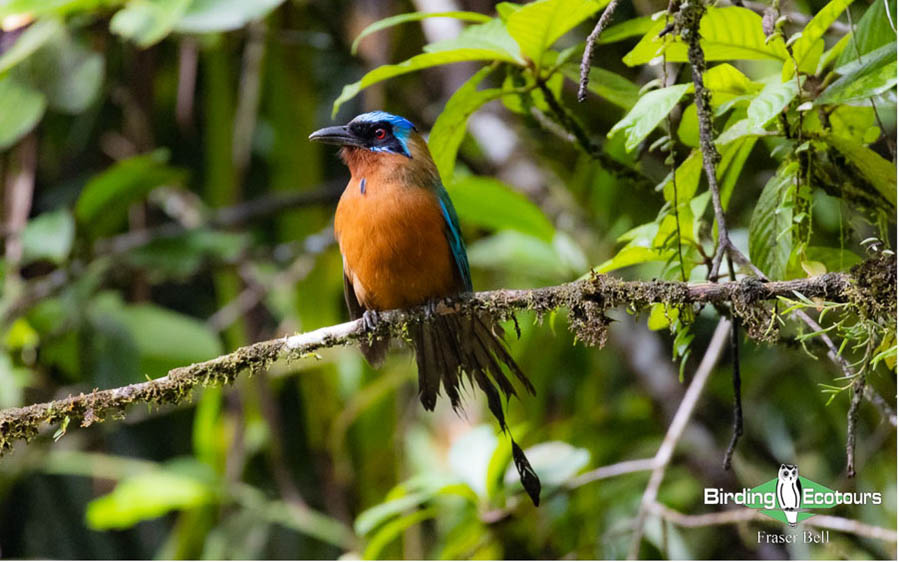
After four nights on Tobago we transfer to Trinidad, famous for its vibrant mix of cultures, excellent tropical weather, and great hospitality. During our time on Trinidad, we stay at the Asa Wright Nature Centre, a world-leading conservation-focused ecolodge. Asa Wright is well known among birdwatchers – its extensive grounds wind through pristine rainforest which boast Bearded Bellbird and the most accessible Oilbird roost in the world, while relaxed birdwatching from the veranda allows close viewing of charismatic and colorful species, such as Blue Dacnis and Tufted Coquette.
We will explore Trinidad’s wetlands, savannah, forests, and coastline, using Asa Wright as our comfortable base, while we seek specials such as Black Hawk-Eagle, Masked Cardinal, Lilac-tailed Parrotlet, and Red-bellied Macaw. During a scenic boat cruise, we’ll witness the breath-taking spectacle of thousands of Scarlet Ibis as they return to roost. After five nights at Asa Wright, we will end the tour with two nights in the northeast, where we target Trinidad’s one true endemic, the Trinidad Piping Guan. A species once widespread across Trinidad, it is now red-listed by the International Union for Conservation of Nature (IUCN) as Critically Endangered and clings on in the remote forests of Trinidad’s mountainous northern range.
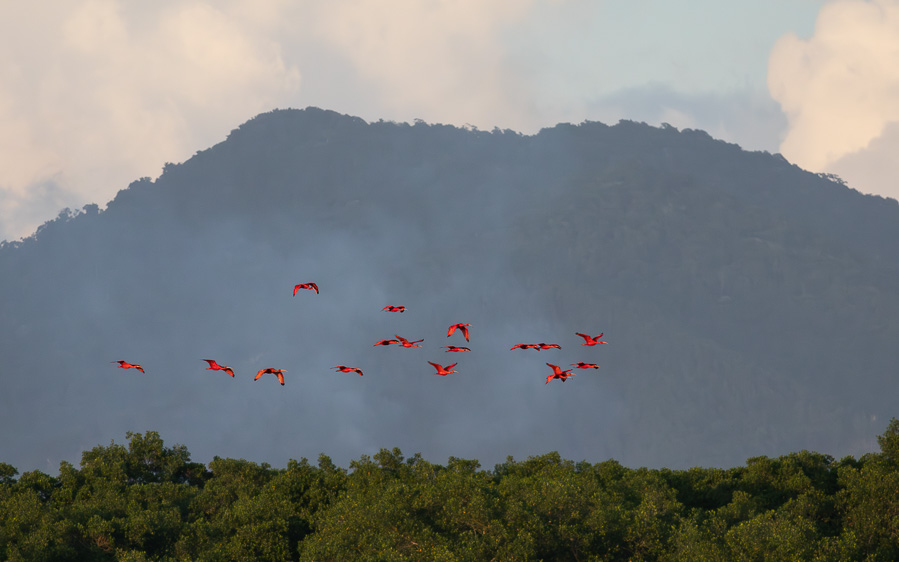
This is a relatively easy tour, in which we hope to become accustomed to many neotropical bird families at leisure, with great photographic opportunities of many spectacularly colorful species. Additionally, we should find the two endemics without too much trouble. This birding trip has been designed so that we have time to enjoy the wonderful birds of the islands at a steady pace, taking advantage of the relaxing Caribbean culture.
We offer other great tours to the Caribbean region including Cuba, Dominican Republic, and Jamaica, as well as birding tours to Guyana or Colombia. These destinations may be combined with Trinidad and Tobago to give a more complete exploration of the region! Please do not hesitate to ask any questions.
Itinerary (12 days/11 nights)
Day 1. Arrival on tranquil Tobago
Today is a travel day and you can arrive at your leisure into Robinson International Airport in Tobago, before transferring to the north-eastern tip of the island to start our two-night stay at a beautiful beach-front hotel. Here the group will have the chance to meet over dinner, discuss the tour and enjoy the breath-taking views across the bay.
Overnight: Blue Waters Inn
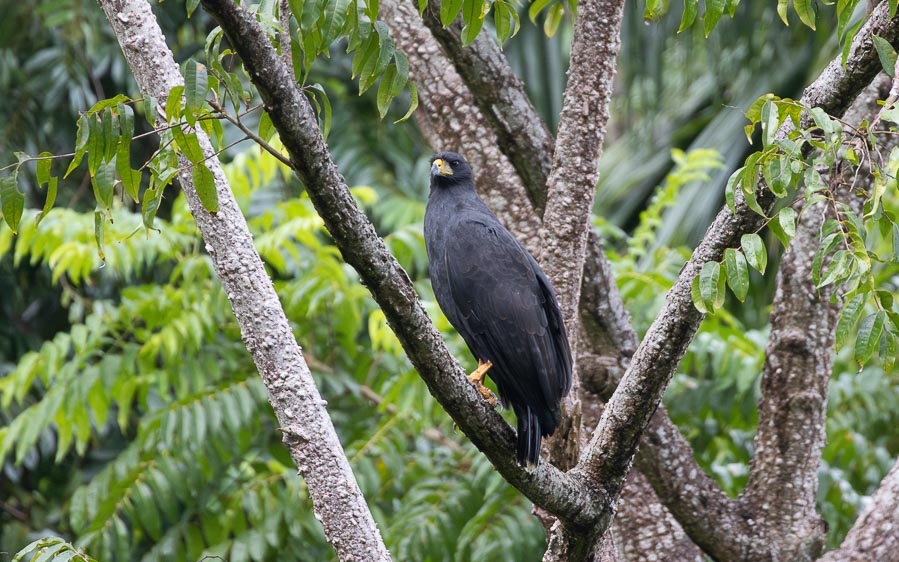
Day 2. Little Tobago Island
An easy morning around the hotel grounds will provide a great introduction to birding in Tobago, where we will inevitably encounter the raucous Rufous-vented Chachalaca, alongside Red-crowned Woodpecker, Fuscous Flycatcher, Barred Antshrike, Northern White-fringed Antwren, Scrub Greenlet, and the gorgeous endemic Trinidad Motmot. With luck we might see a Great Black Hawk soaring over the canopy, or Belted Kingfisher foraging along the shore. In the late morning we will board a boat trip to Little Tobago Island. Magnificent Frigatebird will escort us on our journey and, through the glass-bottom boat, we will keep our eyes peeled for tropical marine species including Hawksbill or Green Turtle. Little Tobago Island has an interesting history, having once hosted an introduced population of New Guinea’s Greater Bird-of-paradise! These are long extinct on the island; and it is instead a paradise for tropical seabirds where Red-billed Tropicbird, Brown and Red-footed Boobies, Laughing Gull, and Audubon’s Shearwater nest. Here we hope to also find Scaly-naped Pigeon, a Caribbean species at its most southerly limit. Time dependent, there may be the opportunity of snorkeling to enjoy the diverse reefs just offshore. Tonight, there may be the option of night birding from our hotel, to seek White-tailed Nightjar, and the secretive Striped Owl.
Overnight: Blue Waters Inn
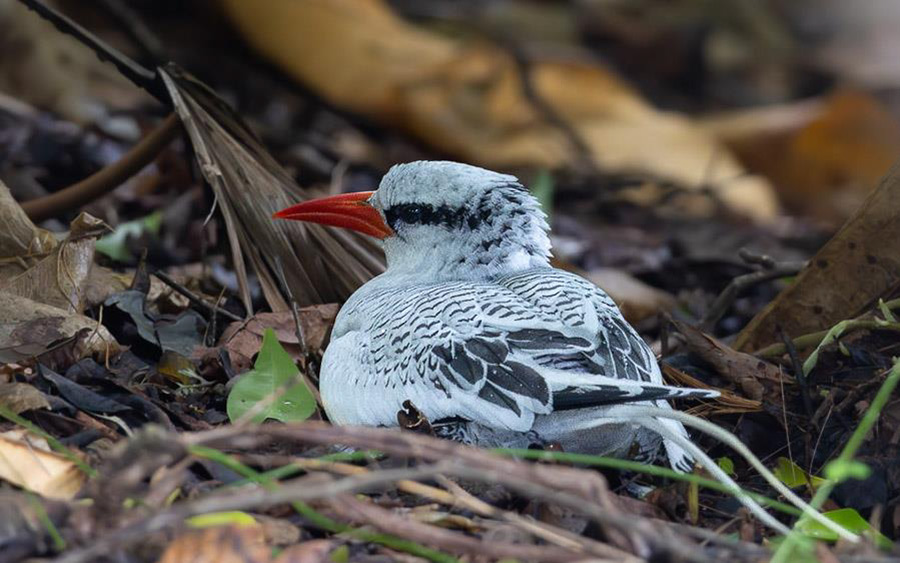
Day 3. Main Ridge
With an early start we depart for Tobago’s Main Ridge mountain range which offers us the best chance for Tobago’s forest specials. Our first stop will be at a viewpoint overlooking the forest, where we will watch commuting birds leaving the forest and raptors, such as impressive Great Black Hawks, soaring over the canopy. Walking quiet mountainous roads, or forested trails, we will target Trinidad Motmot and Rufous-tailed Jacamar, which are more common here than in Trinidad, alongside Blue-backed Manakin, Stripe-breasted Spinetail, Fuscous and Venezuelan Flycatchers, White-winged Becard, White-throated Spadebill, Yellow-legged Thrush, Grey-throated Leaftosser, Olivaceous Woodcreeper, and the Endangered (IUCN) White-tailed Sabrewing, as it visits heliconia and banana flowers. This large and impressive hummingbird is arguably our most important target on Tobago, being confined only to Tobago and the Praia Peninsula in Venezuela. Out of the forest, we visit a hummingbird garden to enjoy close views of Tobago’s six hummingbird species, which alongside the near-endemic White-tailed Sabrewing, include Black-throated Mango, White-necked Jacobin, and the stunning Ruby-topaz Hummingbird – a migratory species which would have recently returned from South America.
Overnight: Comfort Inn Tobago
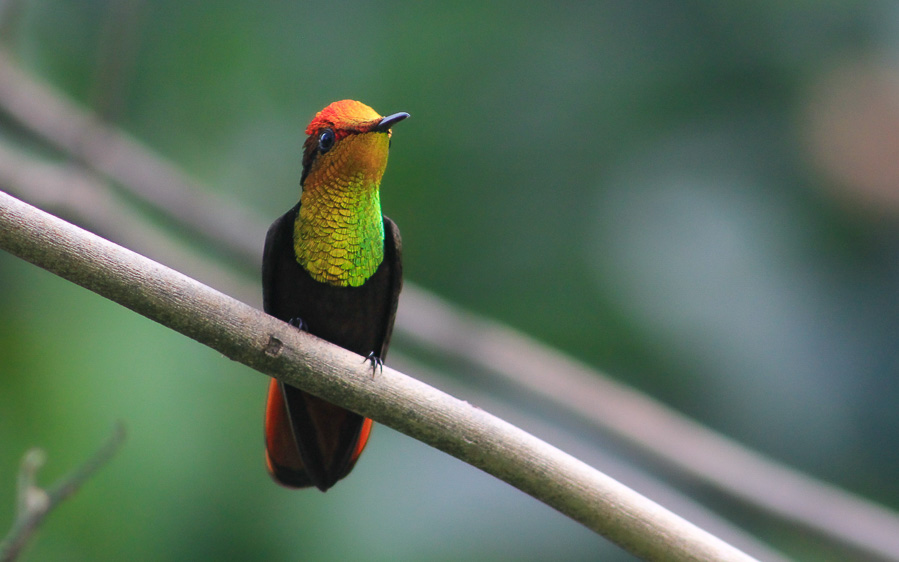
Day 4. South Tobago wetlands
Early morning will see us exploring the south of Tobago, an exciting prospect considering the wetlands here are a hotspot for migratory species overwintering from North America. Within extensive mangroves and overgrown pools, we will target Wilson’s Snipe, White-cheeked Pintail, Least Grebe, Anhinga, Mangrove Cuckoo, Scrub Greenlet, roosting Common Potoo, alongside a supporting cast of wintering Semipalmated and Western Sandpipers, Lesser and Greater Yellowlegs, Hudsonian Whimbrel, Sora, and maybe an early Caribbean Martin. We then visit the most accessible mangrove walkway in Tobago, which makes it one of the best places to see Mangrove Cuckoo. The grounds host a variety of wetland habitats, where we will look for Wattled Jacana, Purple Gallinule, Green-rumped Parrotlet, Black-faced Grassquit, Pale-vented Pigeon, Eared Dove, amongst migratory waterbirds, warblers and swallows.
After lunch there is the option of traveling to the coast to relax at the beach. Here we will keep an eye out for passing gulls, terns, and waders, as this area has a track record of rare vagrants being found. This is a very relaxing place to spend an afternoon.
Overnight: Comfort Inn Tobago
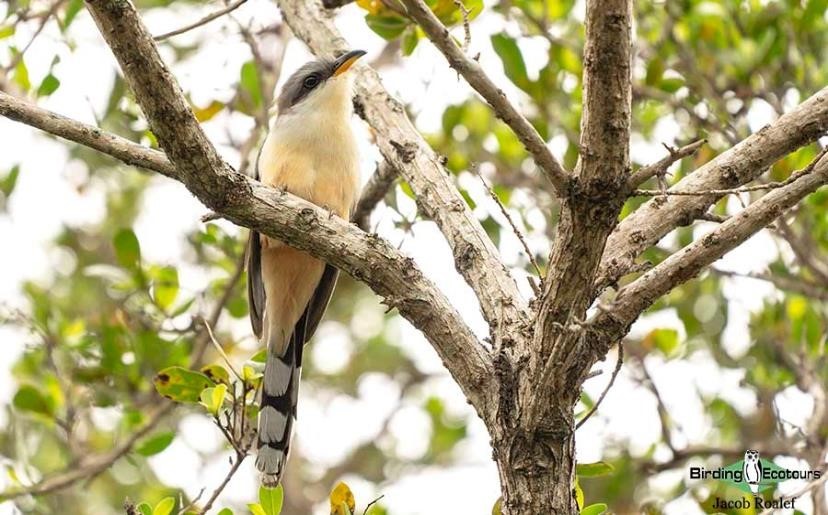
Day 5. Transfer to Trinidad and the Asa Wright Centre
We board an early flight to Trinidad’s Piarco International Airport and, on arrival in Trinidad, we will spend a short time birding wetlands near the airport for species including Pied Water Tyrant, White-headed Marsh Tyrant, Yellow-chinned Spinetail, Saffron Finch, Ringed Kingfisher, Rufous-browed Peppershrike, Green-rumped Parrotlet, amongst herons and waders. Our main targets are Red-breasted Blackbird and Ruddy-breasted Seedeater, which is now rare in Trinidad, having suffered due to its popularity in the pet trade. After our visit to Trinidad’s bustling lowlands, we will be taken the short distance into the solitude of the northern range, to start our five-night stay at the famous Asa Wright Nature Centre.
Here the group will enjoy brilliant birding, and breath-taking views from the comfort of the veranda. Here we hope to be joined by vibrant Purple, Green and Red-Legged Honeycreepers, Violaceous Euphonia, Turquoise Tanager, and more than ten hummingbird species are regularly seen here, including the impressive Tufted Coquette, Little Hermit and Long-billed Starthroat. The veranda provides a good viewpoint across the forested valley, and we may spot Black Hawk-Eagle, Short-tailed Hawk, Scaled Pigeon, Lilac-tailed Parrotlet, Orange-winged Amazon, or our first Channel-billed Toucan over the forest canopy below. We will spend some time night birding the entrance road and grounds, searching for Short-tailed Nighthawk, Spectacled Owl, Mottled Owl and Ferruginous Pygmy Owl, amongst mammals, reptiles and amphibians, which the Asa Wright guides excel at finding.
Overnight: Asa Wright Nature Centre
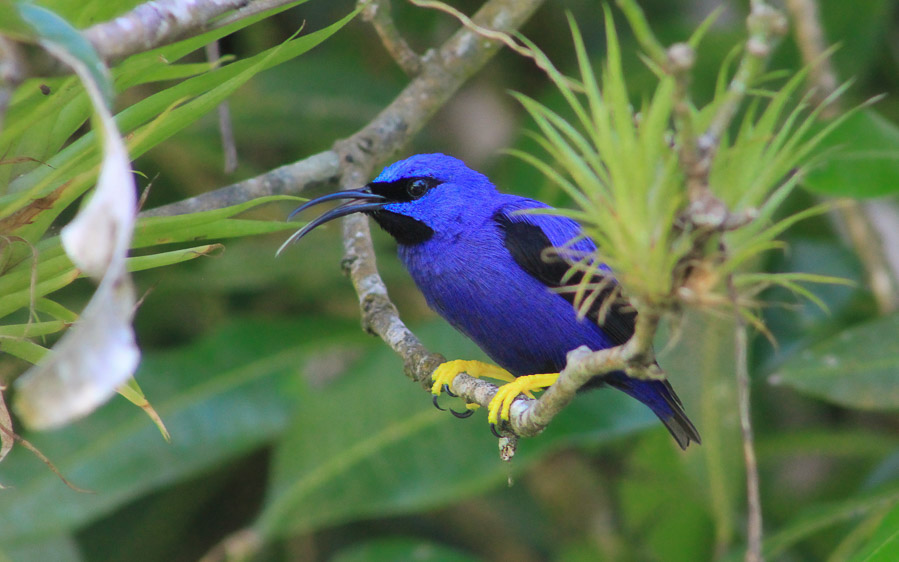
Day 6. A gentle introduction to birding in Trinidad
Today, we will bird at a comfortable pace, true to Caribbean style. We will spend an entire day within the grounds of the Asa Wright Nature Centre where over 200 bird species have been recorded. Watching from the veranda we hope to be joined by the species mentioned for the previous day and many more, including skulking Barred Antshrike and Long-billed Gnatwren, alongside Black-tailed Tityra, Cocoa and Plain-brown Woodcreeper, while Blue Dacnis, Bay-headed Tanager and Trinidad Euphonia can be seen in the canopy of flowering trees. Around the network of well-maintained trails, we hope to see Squirrel Cuckoo, Green Hermit, Crimson-crested and Lineated Woodpecker, Ferruginous Pygmy Owl and, if we’re lucky, we may find a lek of displaying White-bearded or Golden-headed Manakins. Asa Wright is home to all three species of trogon found within Trinidad, and the highly ventriloquial Bearded Bellbird, whose deafening call resembles that of a hammer hitting an anvil. In the afternoon we will have a memorable visit to the Dunstan Caves’ active Oilbird colony – their aroma and raucous calls will be hard to forget! Since 2024, there have unfortunately been fewer Oilbirds in the caves, possibly due to blast mining further up the valley. However, we will do our best to see as many of these truly unique birds as possible, and with five nights at Asa Wright, we will have multiple opportunities to visit the caves, if needed.
Overnight: Asa Wright Nature Centre
Day 7. Western coastal Trinidad
With an early departure from Asa Wright, we will travel to Trinidad’s western coastline which, with extensive mudflats, mangroves and wetlands, makes for exciting birdwatching. Walking along quiet waterways and water meadows, we will search for Spotted Tody-Flycatcher, Pied Water Tyrant, Masked Cardinal, Bicolored Conebill, Long-winged Harrier, Black-crested Antshrike, Yellow-hooded Blackbird and, if we’re lucky, one of the specialized mangrove residents, such as Mangrove Rail, Mangrove Cuckoo, or Rufous Crab Hawk. At the mudflats of Orange Bay, we will enjoy aggregations of migratory shorebirds alongside resident waterbirds, before finishing the day with an afternoon boat trip through the Caroni Swamp.
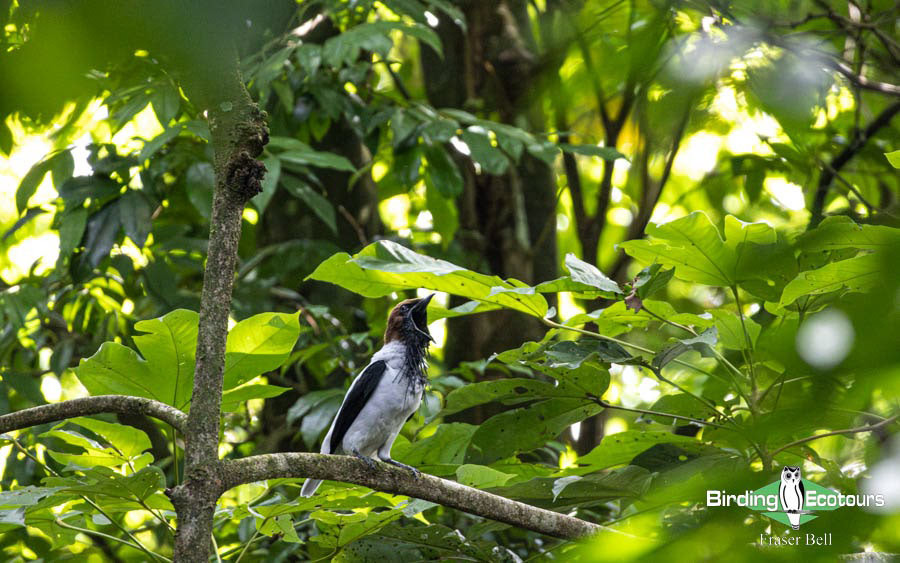
We will traverse the network of channels between the mangroves, seeking out more of Trinidad’s mangrove specials, such as Green-throated Mango, Grey-cowled Wood Rail, Boat-billed Heron and hope to find the small population of American Flamingo which have recently colonized the swamp. Our local guides excel in finding roosting Tropical Screech Owl and Common Potoo, as well as Ruschenberger’s Tree Boa and Silky Anteater in the twisted branches of the mangroves. As the sun sets, we can enjoy the spectacle of thousands of Scarlet Ibis returning to roost on mangrove islets, an unforgettable experience for many.
Overnight: Asa Wright Nature Centre
Day 8. East Trinidad
In the morning we will visit one of the last remnants of tropical savanna in Trinidad, at Aripo agricultural station. Exploring the farm tracks and quiet roads, we will look for Striped Cuckoo, White-headed Marsh Tyrant, Red-breasted Blackbird, Yellow-chinned Spinetail and Savanna Hawk, among many others, and if we’re lucky, we may see Ruddy-breasted Seedeater, or Brown-throated Parakeet, both of which are now rare and localized in Trinidad.
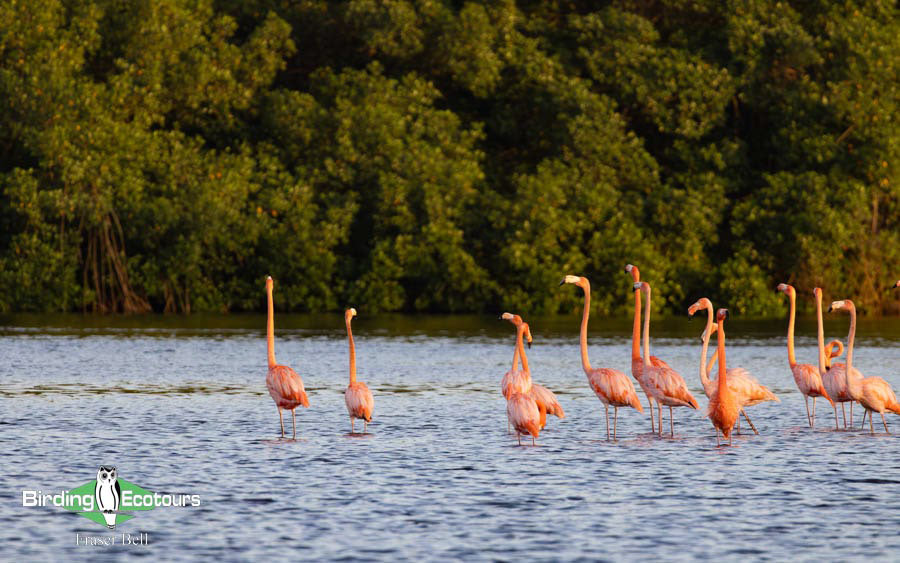
Travelling east we plan to stop for some local food – doubles or Aloo Pie are often the favorites – then continue to the coast. Here we seek Crested Caracara, Sulphury Flycatcher, White-tailed Goldenthroat, and Little Cuckoo. In the afternoon we will explore the Nariva Swamp, walking along small tracks, we will seek Pinnated Bittern, Limpkin, Wattled Jacana, Purple Gallinule, and Red-bellied Macaw, and hope to find a flock of reintroduced Blue-and-yellow Macaw. With its quaint mix of agricultural paddies, interspersed with swamp forest and freshwater marshes, it is an idyllic setting for an afternoon.
Overnight: Asa Wright Nature Centre
Day 9. The Northern Range
On our final full day at Asa Wright Nature Centre, we will explore north of the center along Blanchisseuse Road into the Arima Valley, stopping at several birding hotspots such as Las Lapas and Paria Junction. Our first stop early on will be at a viewpoint overlooking the forest below, where we will enjoy seeing flocks of Blue-headed Parrot as they leave their roost, and hopefully the near endemic Lilac-tailed Parrotlet. The diversity of birds here is impressive, as most of Trinidad’s forest species are present in the area, but our main targets are higher altitude specials, including Ornate and Black Hawk-Eagles, Scaled Pigeon, Slaty-capped Flycatcher, Golden-crowned Warbler, Sooty Grassquit, Great Antshrike, Speckled, and Swallow Tanagers.
Overnight: Asa Wright Nature Centre
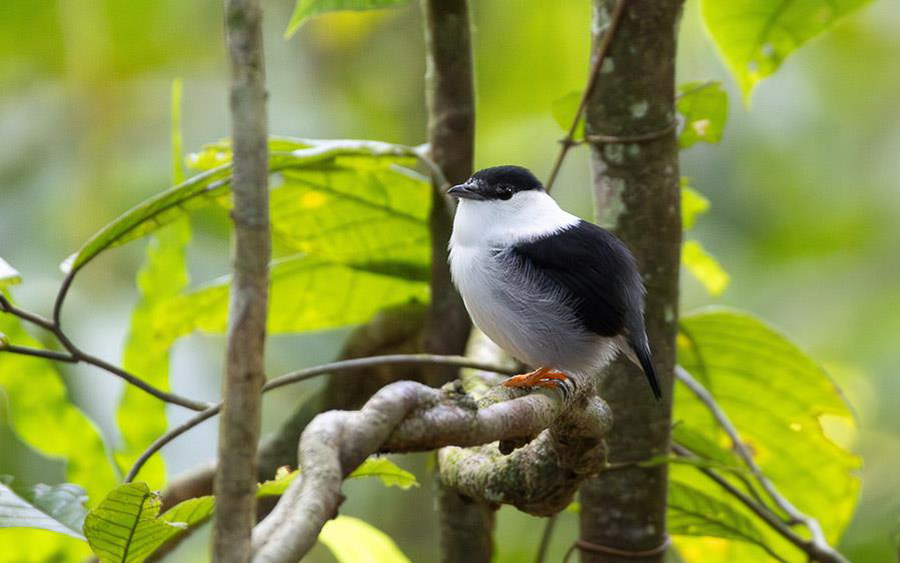
Day 10. Transfer to Grand Riviere
We will enjoy a relaxed final morning spending more time on the trails and veranda at Asa Wright. Here, we will continue to seek skulking species such as Grey-throated Leaftosser, White-bellied Antbird, Little Tinamou, Black-faced Antthrush, Silvered Antbird, Great Antshrike, and less common species such as Little Hermit, Chestnut Woodpecker and Euler’s and Olive-sided Flycatchers.
After lunch, we transfer to Trinidad’s northeast, where we will spend two nights at the remote village of Grand Riviere, which lies at the base of the extreme northeast of the Andes Mountain Range. If time allows on arrival, we may start to explore the local area, though some may instead choose a swim, or a walk on the beach right outside the hotel.
Overnight: Mount Plaisir Estate Hotel
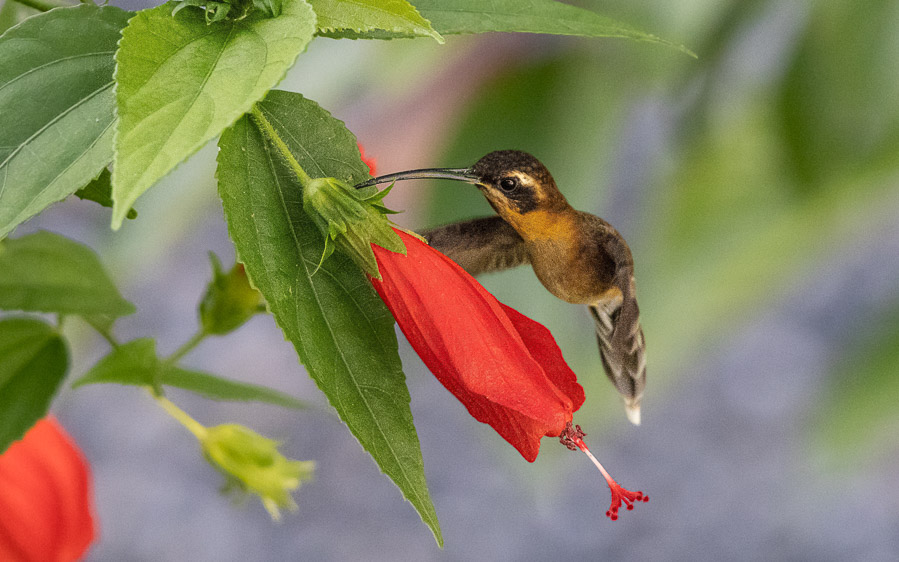
Day 11. Birding Grand Riviere
An early departure will see us on the quest for Trinidad’s secretive and threatened, Trinidad Piping Guan. Due to overhunting, it is confined to this remote region and we will make a special effort to find this bird. Watching from a viewpoint, we hope to see the piping guans as they leave their roost and feed in nutmeg trees, before they melt away into the forest canopy. After our vigil, we will continue to bird locally. This area is comprised of a mix of riverine forest and cultivated habitats which attract a range of interesting birds such as Trinidad Euphonia, Black-tailed Tityra, Lilac-tailed Parrotlet, White-winged Becard, Crimson-crested Woodpecker, Silvered Antbird, Little Tinamou, Boat-billed Flycatcher, Ferruginous Pygmy Owl, Bat Falcon, Grey-headed Kite, and White-bellied Antbird, while Green and Ringed Kingfishers, and Little Blue, and Great Blue Herons could be found along the coast, alongside migratory shorebirds. The afternoon will be spent at leisure, enjoying the peace of Grand Riviere.
After one last good day, we will have our final group dinner of the tour where we will discuss the ‘bird of the trip’ – it is sure to be a tough task!
Overnight: Mount Plaisir Estate Hotel
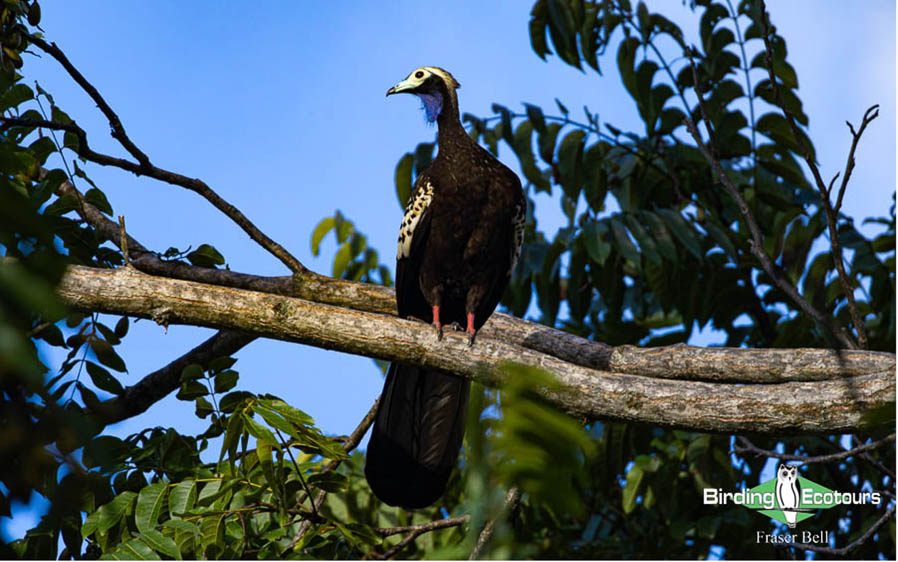
Day 12. Departure
We will sadly depart our tropical paradise after one final tasty breakfast and drive south towards the airport. On the way, we will visit a beautiful and active hummingbird gallery deep in the forested mountains, where we hope to get improved views of all the hummingbirds we have seen during our time in Trinidad. Importantly, we hope to improve our views of the staggering Ruby-topaz Hummingbird, including the opportunity of taking photographs of a male. We will have a local lunch (and some of the best coffee in Trinidad) and enjoy some final birding in this peaceful setting. The tour will conclude around 2pm when we return to Piarco International Airport. If you would like to overnight in Trinidad after the tour, please let us know and we can suggest good hotels near the airport, and help you book these.
Overnight: Not included
Please note that the itinerary cannot be guaranteed as it is only a rough guide and can be changed (usually slightly) due to factors such as availability of accommodation, updated information on the state of accommodation, roads, or birding sites, the discretion of the guides, and other factors. In addition, we sometimes have to use a different guide from the one advertised due to tour scheduling or other factors.
Download ItineraryTrinidad and Tobago Birding Tour: An Introduction to Neotropical Birding Trip Report
28 NOVEMBER – 09 DECEMBER 2024
By Fraser Bell
DOWNLOAD TRIP REPORT
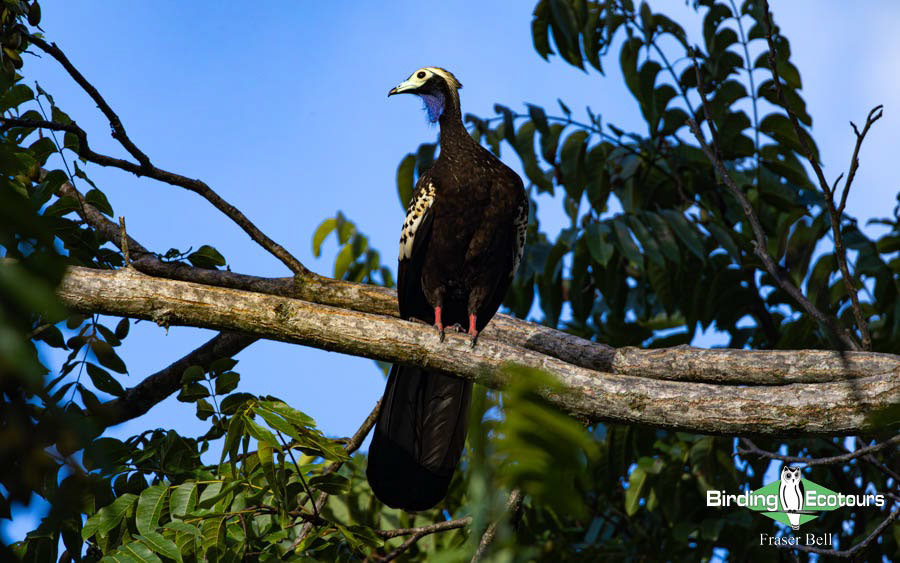
We had repeated views of the Critically Endangered Trinidad Piping Guan in the remote forests of Grand Riviere.
Overview
This birding tour of Trinidad and Tobago began in northeast Tobago on the 28th of November 2024, and concluded in Piarco, Trinidad, on the 9th of December 2024. The tour focused on seeing a broad range of species from Neotropical bird groups, from hummingbirds, trogons, and tanagers, as well as targeting specials such as Oilbird, Bearded Bellbird,nesting Red-billed Tropicbird, and the spectacle of thousands of Scarlet Ibis coming to roost. We had excellent views of all these, along with repeated encounters with the country’s two true endemics, Trinidad Piping Guan and Trinidad Motmot,and several near-endemics including Lilac-tailed Parrotlet, and White-tailed Sabrewing.
We began the tour by birding across Tobago. We first visited the raucous seabird colonies on Little Tobago Island, then searched for Tobago’s shy forest species in the dense interior of the Main Ridge Reserve, and finished our time on the island by covering a range of coastal and wetland sites including Centre Street Ponds, Bon Accord Sewage Ponds, Tobago Plantation, and Pigeon Point. On arrival in Trinidad we visited Trincity Sewage Pools before continuing to the Asa Wright Centre, where we checked in for a five-night stay. From here we explored the dry savannah at Aripo, the Nariva Swamp, and the high elevation forests along the Blanchisseuse Road. We also made the most of an afternoon boat trip through Caroni Swamp, spotlighting for nocturnal wildlife on the way out, and made the most of the birding and relaxed pace at Asa Wright throughout. We then transferred to the northeast for two nights at a remote coastal hotel in Grand Riviere, searching for the Critically Endangered (BirdLife International) Trinidad Piping Guan and other forest species. Our final birding was at a lively hummingbird garden on the way to the airport.

The near-endemic White-tailed Sabrewing is an impressive hummingbird and a big target during our time in Tobago.
We recorded 222 bird species on this Trinidad and Tobago birdwatching tour (with four of these heard only). Aside from the species mentioned above, other highlights seen on the tour included Mangrove Cuckoo, Ruby-topaz Hummingbird, Tufted Coquette, American Flamingo, Red-footed Booby, Scarlet Ibis, Ornate and Black Hawk-Eagles, Guianan Trogon, American Pygmy Kingfisher, Rufous-tailed Jacamar, Channel-billed Toucan, Blue-and-yellow Macaw, Blue-backed, White-bearded and, Golden-headed Manakins, Yellow-legged Thrush, Trinidad Euphonia, Masked Cardinal, Bicolored Conebill, and Ruddy-breasted Seedeater. We also enjoyed finding several country rarities including the first record of Snail Kite for Tobago, and Rufous Crab Hawk, Summer Tanager and Variegated Flycatcher in Trinidad.
In addition to the exceptional birding, we encountered a range of other wildlife, including reptiles such as Spectacled Caimen, Black Tegu, several snakes including Ruschenberger’s Tree Boa, and the Tobago endemic, Eyespot Gecko. Mammalian highlights included watching Greater Bulldog Bats fishing at dusk in the Caroni Swamp, and Greater Spear-nosed Bats drinking nectar from hummingbird feeders outside our accomodation in Tobago.
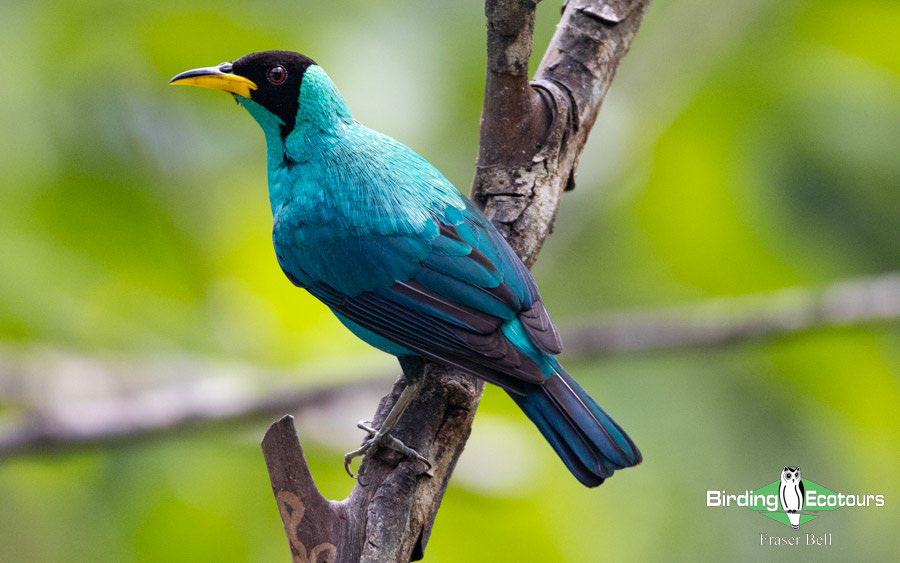
We were treated to brilliantly colorful species throughout our time in Trinidad and Tobago, such as this Green Honeycreeper.
Bird and animal lists for this Trinidad and Tobago birding tour follow the report and you can also view the eBird trip report here, where you can see more bird photos.
Detailed Report
Day 1, 28th November 2024. Arrival into tranquil Tobago
Today was an arrival day with the group meeting over dinner at our hotel in northeast Tobago. Over our first of many amazing Caribbean meals, we discussed the upcoming tour, our top bird and animal targets for the next two weeks, and celebrated an impressive wedding anniversary within the group.
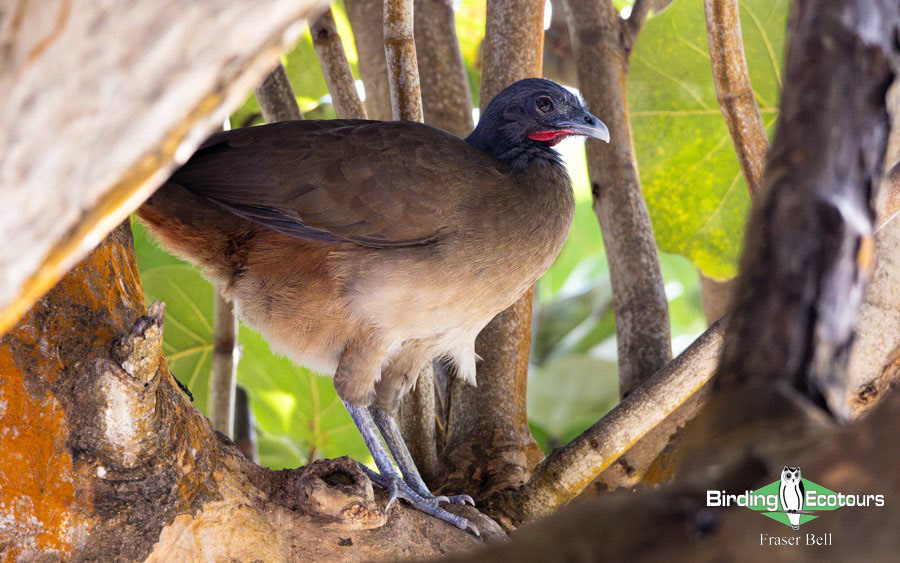
Loud and animated groups of Rufous-vented Chachalacas welcomed us to Tobago.
Day 2, 29th November 2024. Little Tobago Island
For the early risers, some birding at first light produced our first of many Copper-rumped Hummingbirds, Barred Antshrikes, Yellow-bellied Elaenias, and Ospreys, plus Northern White-fringed Antwrens and a Scrub Greenlet, which is not found on Trinidad, and a Fuscous Flycatcher, which is much more reliable on Tobago. Over breakfast we enjoyed watching Brown Pelicans plunge diving into the azure Caribbean Sea, and afterwards we boarded our glass-bottom boat to Little Tobago Island. On arrival, we were greeted by a stunning Trinidad Motmot – a great way to kick off the tour with one of the two country endemics! At the top of the island, we had excellent views of nesting Red-billed Tropicbirds, Brown and Red-footed Boobies, and Magnificent Frigatebirds as they returned to their nests in the forests around us. Some frigatebirds were actively chasing tropicbirds, which was quite the spectacle to watch, and a surprise vagrant Crested Caracara was an unexpected highlight. While on the island we also saw Brown-crested Flycatchers, Northern Waterthrushes, Peregrine, and plenty of tiny Ocellated Geckos, a Tobago endemic. The frigatebirds escorted us away from the island, and we then toured the reef from the boat, seeing plenty of colorful fish despite the unfortunate visible coral bleaching.
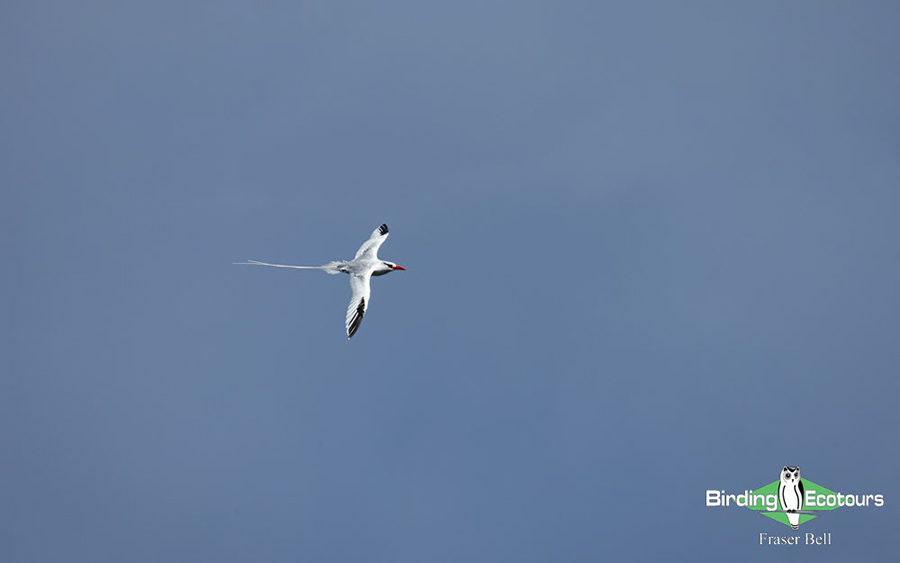
There is a healthy population of elegant Red-billed Tropicbirds nesting on Little Tobago Island.
After a nice lunch, where we were joined by Ruddy Turnstones and Bananaquits trying to raid our drinks, and a few Rufous-vented Chachalacas awkwardly sat in the tree next to our table, we had some down time. In the afternoon most of the group walked a quiet road near the hotel, birding dry scrub forest. This proved productive, and in addition to the species we saw on the pre-breakfast walk, we added Pale-vented Pigeons, White-tipped Doves, Short-tailed Swifts, Blue-black and Black-faced Grassquits, and the subtly beautiful Ochre-lored Flatbill. We gathered before dinner to enjoy some drinks on the peaceful restaurant decking, listening to the waves and chatting, and after dinner watched a party of Greater Spear-nosed Bats raiding hummingbird feeders with their impressively long tongues.
Day 3, 30th November 2024. Tobago’s Main Ridge Reserve
Leaving before breakfast we headed south towards Tobago’s Main Ridge Reserve. Our first stop was near Argyll waterfall where we saw the cryptically plumaged Common Potoo on a day roost, plus, our first Violaceous Euphonia, Cocoa Woodcreeper, Smooth-billed Anis, Little Blue Heron, and Spectacled Thrushes. We continued up into the Main Ridge Reserve, one of the world’s oldest protected forests. Birding along the main road through the reserve was very productive, with Fuscous Flycatcher, Golden-olive Woodpecker and plenty of Trinidad Motmots and Rufous-tailed Jacamars close to the roadside, allowing good photographic opportunity. A roadside stop gave amazingly close views of a pair of perched Orange-winged Amazons (a common species but often seen in flight or in the distance), but the highlight was a trio of Blue-backed Manakins, including two cracking males feeding in a fruiting tree beside the road. Unfortunately, although we heard Venezuelan Flycatcher calling a few times, it stayed hidden in the canopy.

The endemic Trinidad Motmot is wonderfully common on Tobago.
After breakfast overlooking the forest canopy and the Caribbean Sea beyond, we headed to Gilpin Trace, a trail through tall, old rainforest. We quickly picked up a pair of Plain Antvireos, then added more targets including Stripe-breasted Spinetails, Olivaceous Woodcreeper, White-necked Thrush, Rufous-breasted Wren, and another pair of Blue-backed Manakins. A Yellow-legged Thrush perched to give most in the group brief views, before it quickly continued into the forest understory, and a stealthy White-throated Spadebill sally-feeding in the mid-canopy took some searching before we found it. Having successfully seen our targets, we left the forest trail to have some more relaxed birding at a hummingbird gallery over lunch. Here, at least 30 near-endemic White-tailed Sabrewings were on show. It was such a treat to be surrounded by them as they fed around us, their gleaming white tails flashing in the sun. Also in attendance were Rufous-breasted Hermits, Grey-rumped Swifts, and White-lined Tanagers, amongst others, and a Red-tailed Squirrel sampling the fruit tables. The standout moment came when our last major target, a Great Black Hawk, circled below us, backlit against the distant sea. We eventually tore ourselves away and continued south to our next hotel overlooking Scarborough harbor. Along the way we enjoyed a cold drink overlooking the picturesque Castara Bay, where we picked up Royal Terns, White-winged Swallows, and more Red-footed and Brown Boobies.
Day 4, 1st December 2024. South Tobago wetlands
After a leisurely breakfast we traveled the short distance to Centre Street Ponds, a group of four pools tucked behind the busy streets of Bon Accord and surrounded by scrub. These are a magnet for waterbirds, and we recorded six species of waterfowl, including the resident Black-bellied Whistling Duck, Blue-winged Teals, White-cheeked Pintails, and three rare migrants, two Lesser Scaups, a Ring-necked Duck, and an American Wigeon. A group favorite was the Least Grebes, likely thanks to three small chicks. Around the pond margins we saw many common waterbird species, including Green and Black-crowned Night Herons, Western Cattle and Great Egrets, and many Anhingas. A scan of a perched flock of resident White-winged Swallows turned up six Sand Martins, a single Barn Swallow, and a rare American Cliff Swallow, all winter visitors. Despite already finding some vagrants here, our rarest bird of the tour came next, in the form of a juvenile Snail Kite flying over the ponds, which gave us the honor of finding the first record for Tobago!

Although it has a large global range, Mangrove Cuckoo can be a tough bird to see and we spent time with this inquisitive bird in southern Tobago.
At Bon Accord Sewage Treatment Ponds we had our best views of Purple Gallinule for the trip, along with improved views of Black-bellied Whistling Ducks. The most productive birding came just outside the ponds along quiet roads and drainage ditches lined with open scrubby woodland. Here we saw Red-crowned Woodpecker, along with Eared Doves, Pale-vented Pigeons, a Belted Kingfisher, Wattled Jacanas, Tricolored and Great Blue Herons, and most of our wading birds of the trip: Least Sandpiper, Short-billed Dowitchers, Greater and Lesser Yellowlegs, Semipalmated Plovers, and Hudsonian Whimbrels. Our final birding stop of the morning was the mangroves at Tobago Plantations where we found another rare migrant, a Pied-billed Grebe (safe to say the guides were the most excited about this find!). Although the boardwalk was a great setting, it was quiet, save for a Parrot Snake. We eventually had excellent views of our target Mangrove Cuckoo as it hopped through the branches above us, watching the group cautiously. After a brilliant lunch stop, we returned to the hotel and spent the early afternoon relaxing – what a morning!
Once the sun had cooled off, most of the group headed to Pigeon Point, a coconut-lined beach at Tobago’s southwest corner. Some swam, others had a drink, and we all connected with a Common Tern (which isn’t common here!), found while sitting on a bench overlooking the crashing waves. Birding was otherwise fairly quiet, with the usual raucous groups of Royal Terns and Laughing Gulls on the fishing boats and buoys, Brown Pelicans plunge diving just offshore and Carib Grackles and Ruddy Turnstones feeding around our feet.
Day 5, 2nd December 2024. Transfer to Trinidad and the Asa Wright Centre
Those who joined the pre-breakfast birding walk around the hotel grounds added American Yellow Warbler to the group list and soaked up our last views of some Tobago specials, such as Trinidad Motmot. Our short flight to Trinidad had been brought forward so, after a quick breakfast, we left for the airport, but only after a group of Green-rumped Parrotlets delayed our departure as they flew into a tree right outside the hotel entrance. Close views of this subtly beautiful species were much appreciated.
We arrived into Trinidad mid-morning and first checked the wetlands near the Millennium Lakes Golf Course. We started familiarizing ourselves with common species in Trinidad, with the highlights being Red-breasted Meadowlark, American Pygmy and Ringed Kingfishers, Pied Water Tyrant, Yellow-chinned Spinetail, and Saffron Finches, plus a group of migratory Black-necked Stilts and a few Spot-legged Wood Turtles. A lunch of roti, curry, and ice cream gave everyone a real taste of Trinidad before we began the drive north to the Asa Wright Centre, following the winding Blanchisseuse Road into the forested northern range. A short birding stop along the way was very productive, and we had views of a displaying male White-bearded Manakin, along with a Tufted Coquette trap-line feeding, a White Hawk, Ochre-bellied Flycatchers, and a Golden-fronted Greenlet.
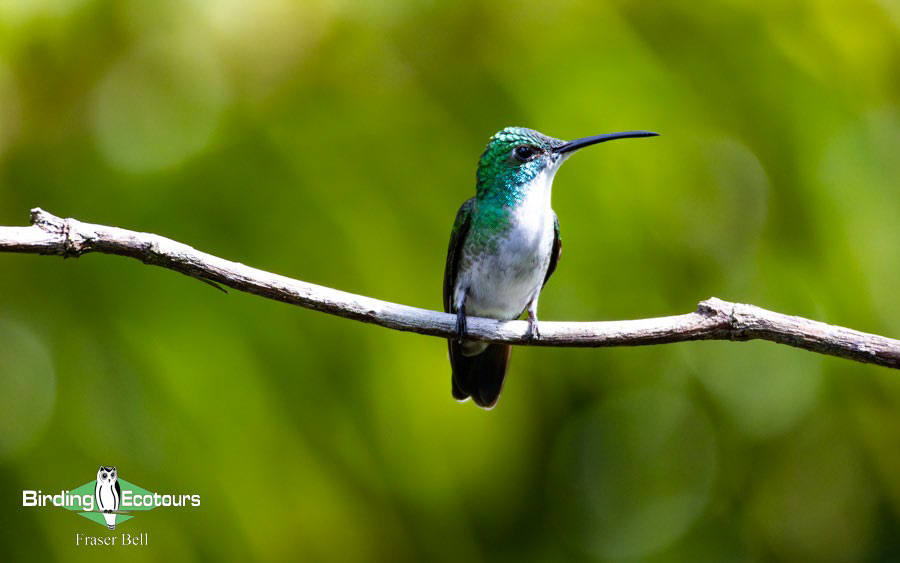
The Asa Wright Centre veranda is ideal for relaxing and watching species like this charming White-chested Emerald.
The Asa Wright Centre is one of the world’s best ecolodges – great food, comfortable rooms, and world-class birding from the veranda and nearby trails, and everyone thoroughly enjoyed checking in with a rum punch in hand, and walking out onto the veranda to be welcomed by nine species of hummingbirds! These included White-chested Emeralds, a Little Hermit, Blue-chinned Sapphires, a Black-throated Mango, and several stunningly beautiful Long-billed Starthroats. We also saw Squirrel Cuckoo, Crested Oropendolas, Bay-headed Tanager, and both Green and Purple Honeycreepers coming to the feeders. The constant ‘CLANG’ from male Bearded Bellbirds, whistles from Trogons, and nasal calls of Channel-billed Toucans created a wonderfully relaxing atmosphere. After an amazing dinner we headed out for a short night walk, with the highlight being several endemic Trinidad Chevron Tarantulas. Some also saw Short-tailed Nighthawks foraging near some lights, which turned out to be our only sighting on tour.
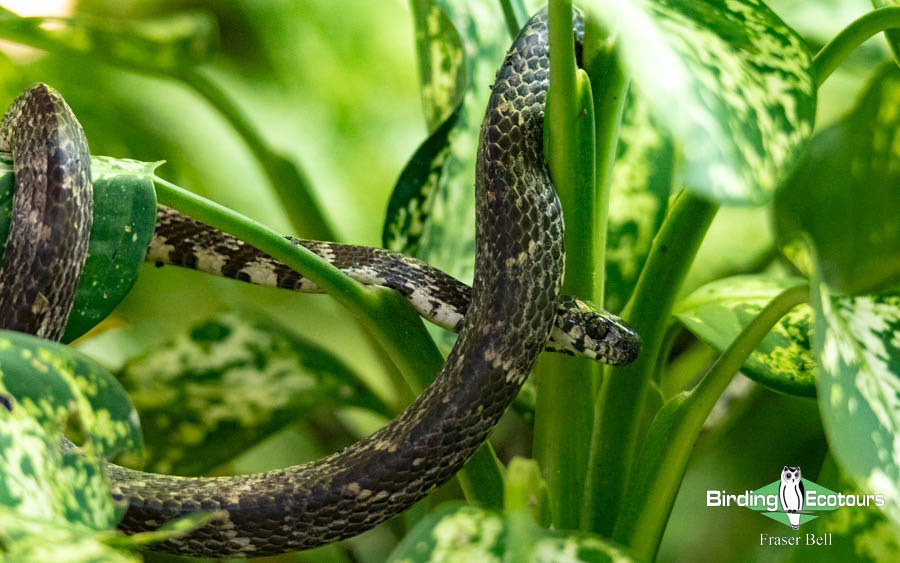
Staying at the Asa Wright Centre is great fun – right in the middle of primary rainforest and immersed in the landscape. This beautiful Cloudy Snail-eating Snake was found right next to the reception!
After a nice local lunch at Brasso Seco village near the northern coast, we headed back along the road towards Asa Wright. Vocal flocks of both Blue-headed Parrots and Lilac-tailed Parrotlets would remain unseen. A small group of Black-tailed Tityras were much enjoyed, as were close views of a cooperative Stripe-tailed Spinetail which flitted around in a fallen tree for the whole group to appreciate. Late afternoon was brilliant for tyrant flycatchers, with Slaty-capped Flycatcher, Yellow-olive Flatbill and Northern Tropical Pewee all seen well, as were a pair of Plain-brown Woodcreepers and a small group of shy and unobtrusive Red-rumped Woodpeckers.
Day 6, 3rd December 2024. East Trinidad
At first light the group gathered on the veranda, enjoying coffee or hot cocoa while watching hummingbirds, honeycreepers, and tanagers up close. After breakfast we headed south and east from the center, to bird the remaining patches of Trinidad’s lowland savanna, a habitat now largely restricted to the Aripo area. We had a successful session, adding a number of lowland species. Highlights included excellent views of Striped Cuckoo, Black-crested Antshrikes, Pale-breasted Spinetail, Blue Dacnis, Southern Beardless-Tyrannulets, Long-winged Harrier, and a shy but unexpected Rufous-tailed Jacamar. We also saw Bran-colored Flycatcher and our only Olive-gray Saltator of the trip. We had poor views of two pairs of Trinidad Euphonias, a big target on this tour owing to its restricted global range. After a bit of effort, the whole group eventually saw a male feeding on mistletoe berries. We arrived at Manzanilla Beach on Trinidad’s eastern coastline, a wild and windswept spot overlooking the Atlantic where strong gusts made for an entertaining lunch. Amazingly, from this spot we could see a nesting pair of Blue-and-yellow Macaws, a species reintroduced to Trinidad after being lost from the island in the 1960s. This impressive pair gave prolonged views as they squawked to each other and showed off their bright plumage while excavating their nest.
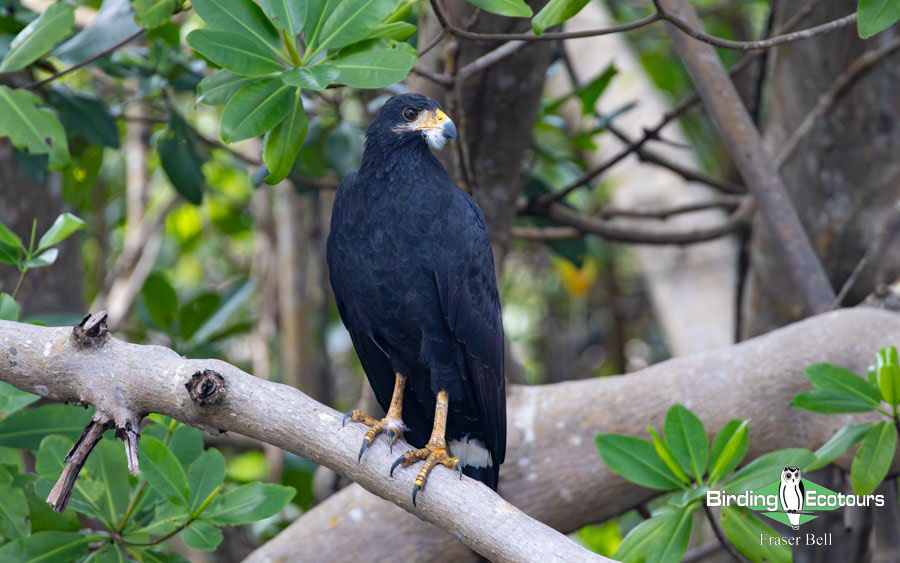
We stumbled upon this impressive Common Black Hawk in some roadside mangroves.
Driving south along the eastern coastline we noted many Savanna and Common Black Hawks, and Yellow-headed Caracaras. We spent an enjoyable afternoon birding the mangroves, flooded grassland, and marshes of Nariva Swamp. In the mangroves we saw Bicolored Conebills, Northern Scrub-Flycatcher, Silvered Antbird, and both American Pygmy and Ringed Kingfishers – the Antbird gave particularly good views as it belted out its repetitive song between the mangrove roots. In the flooded fields we picked up Yellow-hooded Blackbirds and Yellow Orioles, along with regulars but, unfortunately, a lone Masked Yellowthroat was seen by few. The standout birds were two infrequent visitors to Trinidad, found one after the other in neighboring riverside trees: a smart Variegated Flycatcher, and a Rufous Crab Hawk. The hawk was a group favorite, and everyone admired the huge claws it used to crush crabs. Rain moved in and cut our birding short, preventing us from searching for a few remaining targets such as White-tailed Goldenthroat, and Pinnated Bittern, though we did find a smart adult Snail Kite on the return journey.
Day 7, 4th December 2024. Trinidad’s northern range
Over another tasty Trinidad breakfast at Asa Wright, we watched Little Hermit and Tufted Coquette feeding on flowers below the veranda, while Crested Oropendolas squabbled at the fruit table, knocking fruit to the ground for Black Tegu and Tree Runner lizards to feast on. We then set off north to target high-elevation species along Blanchisseuse Road, arriving to Las Lapas in good time. A short walk here proved to be one of our most productive stops of the tour. A slow fly-by Ornate Hawk-Eagle was seen well by all, close enough to appreciate the rufous and black facial markings. We also had another major tour target in the shape of four Lilac-tailed Parrotlets, which briefly perched in a nearby tree. Other highlights included six Channel-billed Toucans (in the same bare tree), both Collared and Green-backed Trogons, Red-rumped Woodpeckers, Golden-crowned Warbler, and a small flock of Yellow-legged Thrushes (which are rare on Trinidad, and of the greyer melanopleura subspecies). A Olive-sided Flycatcher saying its “quick three beers!” call rounded out the walk nicely.
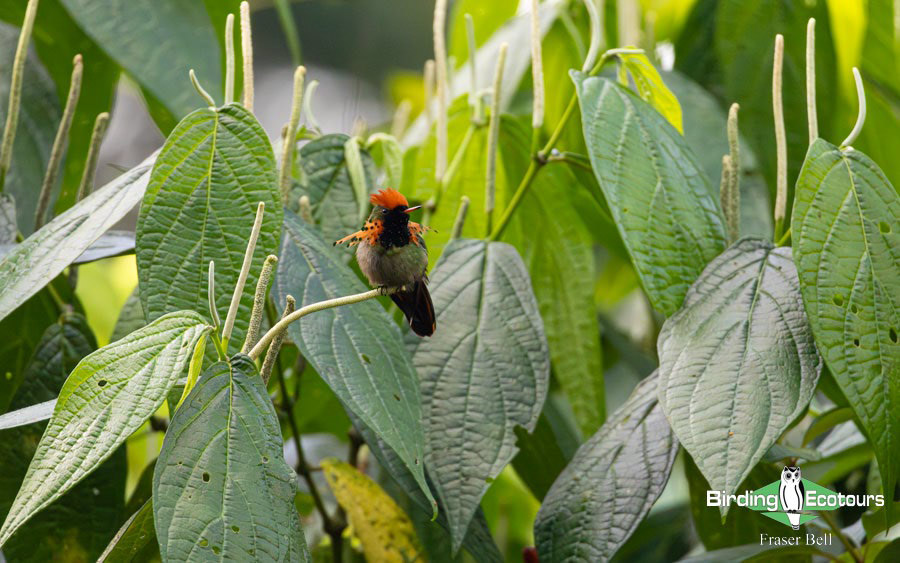
Tufted Coquette are brilliant birds, and rightly group favorites. They are tiny, like a large bee, and have a fun wiggling dance when they feed on nectar!
Further birding along the road proved very productive. We watched two brilliant male Golden-headed Manakins displaying – moonwalking along a branch before flying with whistling pops – when a majestic Black Hawk-Eagle soared low over the canopy. While canopy birding can be hard at times, we saw a lot of species across the morning, adding White-flanked Antwren, Northern Tropical Pewees, Forest Elaenias, American Redstart, Tropical Parula, and White-shouldered Tanager to our group list. After lunch at Brasso Seco, where we also learned about the local chocolate-making process, we birded nearby forest roads. We had quality views of a male Great Antshrike, but the highlight was a pair of Blue-headed Parrots in flight which gave everyone a chance to note their small size, distinct calls, and bright red rumps. A calling Ferruginous Pygmy-Owl delayed us for almost an hour, and we eventually left it without much success (though this was mediated later in the trip). On the way back to Asa Wright we stopped a few more times, seeing many Cocoa Thrush along the roadside and finding a cracking male Summer Tanager, a rare migrant here.

The population of American Flamingo in the Caroni Swamp is expanding.
Day 8, 5th December 2024. Caroni Swamp
We spent the morning exploring the amazing trails at Asa Wright. At dawn we could hear Little Tinamou and Bright-rumped Attila calling from the forest, and the veranda was busy with brightly colored hummingbirds, honeycreepers, tanagers, and Violaceous Euphonias. After breakfast we walked down to the Bearded Bellbird lek, where at least six males were in attendance, and calling in close proximity, with two constantly chasing each other through the trees. The White-bearded Manakin lek was quieter than usual but several males were displaying, their brilliant white beards glowing in the dark understory, until they buzzed after a female that passed through. Other highlights included a male White-bellied Antbird, a pair of Lineated Woodpeckers, and, for those keen enough to make the walk to the roosting cave, the best of the morning was an Oilbird! A true oddity, it’s the world’s only nocturnal, fruit-eating flying bird and the sole member of the Steatornithidae family. After a banquet for lunch, we headed south out of the forest and down into the lowlands again. At the grasslands of Orange Grove we had good looks at two Long-winged Harrier coursing over the fields, and a late Fork-tailed Flycatcher (most had already migrated south) was a surprise.
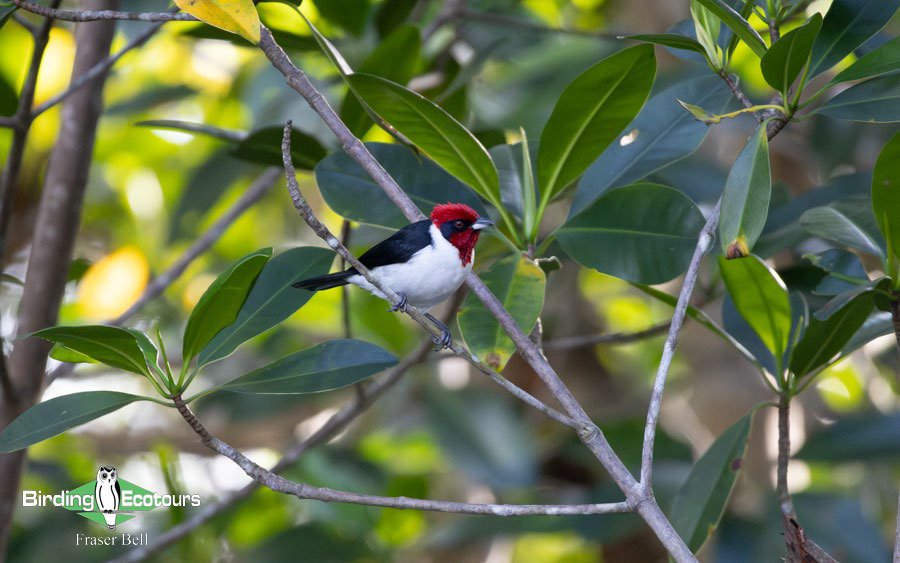
One of the stars of the Caroni Swamp is the Masked Cardinal, a smart-looking bird with a lot of character. This one came close to investigate our group!
The afternoon and evening were spent at Caroni Swamp, which was a major tour highlight, as always. From the boat we had close views of Masked Cardinals, Greater Anis, Scarlet Ibises, Short-tailed and Fork-tailed Palm Swifts, plus a pair of roosting Tropical Screech-Owls, a Green-throated Mango perched high in the canopy, a pair of Straight-billed Woodcreepers, and many Ruschenberger’s Tree Boas. Despite these impressive sightings, the true spectacle of Caroni swamp came at dusk. We watched as hundreds of Scarlet Ibises flew in to roost, joined by American Flamingos, Little Blue, Tricolored, and Great Blue Herons, and Great and Snowy Egrets, turning the green mangrove leaves pink and white from the sheer abundance of birds. We watched this against a backdrop of the setting sun and a brilliant feast on the boat with rum punches. As the sky darkened, we headed back out of the marsh. Spotlighting on the return trip we saw Grey-cowled Wood Rails, Pauraques, a Common Potoo, and watched Greater Bulldog Bat hunting over the water. What a fantastic day!
Day 9, 6th December 2024. Enjoying the Asa Wright Centre
We had a full day at the impressive Asa Wright Centre. Some in the group stayed on the veranda to focus on photography, others swam in the natural pools, but most joined some short birding sessions along the trails to focus on our remaining targets. Highlights from the veranda included Short-tailed Hawk, Channel-billed Toucan, Black-throated Mangos, Long-billed Starthroats, and Bay-headed Tanagers. Tufted Coquette is always the star bird here. This beautiful hummingbird looks akin to a bee due to its small size and it’s bumbling flight behavior which makes it a tricky subject to photograph. Those who explored the trails enjoyed better views of White-flanked Antwrens, Plain-brown Woodcreeper, and added Euler’s Flycatcher, a noisy trio of Red-crowned Ant Tanagers, and an uncharacteristically showy Grey-throated Leaftosser. After afternoon tea on the veranda we had a lone Scaled Pigeon, and our best views of Guianan Trogon. Despite checking both evenings, we heard neither Spectacled nor Mottled Owls during our stay.
Day 10, 7th December 2024. Transfer to Grand Riviere
We had one final morning at Asa Wright. Among the Short-tailed and Grey-rumped Swifts overhead we picked out at least four Chestnut-collared Swifts. Both Green-rumped and Collared Trogons were active and vocal, giving their best views of the tour. The White-bearded Manakin and Bearded Bellbird lek were busy with at least eight males of each on display. One can never tire of these, especially with the constant ‘CLANG!’ calls echoing around the forest.

The Asa Wright Centre is one of the best places in the world to see Bearded Bellbird. Their deafening calls are certainly memorable!
After a leisurely lunch we said our goodbyes to Asa Wright and began the drive to Grand Riviere on Trinidad’s northeast coast. Our progress along this scenic coastal road was slow, so we delayed check-in and headed straight up the Monte Video Road to look for Trinidad’s rarest endemic. We arrived in time to see six Trinidad Piping Guan coming to feed in their favored nutmeg trees. Everyone had excellent views of these odd but impressive birds, a Critically Endangered species and a major tour target. We returned to our beachfront hotel for a well-earned meal and drinks, falling asleep to the sound of the sea at one of the most stunning locations of Trinidad.

Day 11, 8th December 2024. Birding Grand Riviere
At first light we met to have coffee overlooking the pristine beach, then headed back to Monte Video Road. Again we had excellent views of Trinidad Piping Guan, watching them feed and leap between branches while calling and wing-churring. Further along the road we birded in some open forest. We picked up Grey-headed Kite, a pair of vocal Crimson-crested Woodpeckers, Boat-billed Flycatchers, Yellow-olive Flatbill, and Yellow-rumped Caciques, all new for the trip. We also improved our views of Turquoise Tanagers, though the flock remained frustratingly high in the canopy andfly-by Black-tailed Tityras and White-winged Becards were unfortunately brief. A real highlight of the morning was a very responsive Ferruginous Pygmy Owl that gave brilliant views as it flew around calling and drew a crowd of mobbing songbirds – satisfying, given we missed one earlier in the tour.
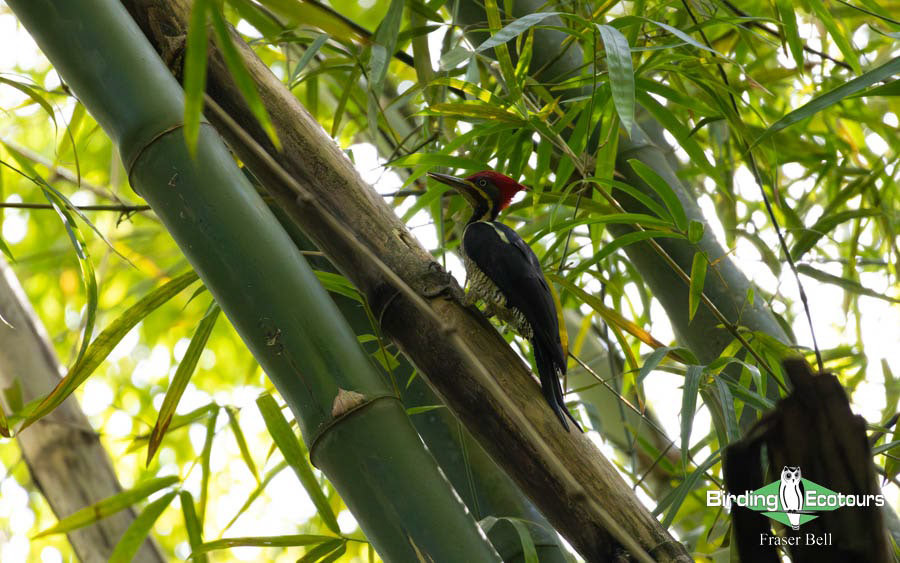
We got close to a pair of Lineated Woodpecker feeding in bamboo while exploring the trails of the Asa Wright Centre.
After breakfast back at the hotel, we returned to a lower section of the hillside road above the hotel. Despite the time of day, bird activity was high, and we encountered a large mixed flock and some fun, fast paced birding followed. Highlights included Chivi Vireo which was new for the trip list, plus the best looks of several more common species. Rain ended the morning early, but a Trinidad Euphonia gave good views just before we left. The afternoon was spent relaxing, with some swimming in the sea or the saltwater pool, others birded from their balconies or enjoyed the view with a coconut juice in hand. That evening, a Trinidad Christmas party was in full swing, with festive food, music, and rum-based eggnog cocktails. Over a memorable final meal we said goodbye to four of the group, as they were departing early to catch their flight back to the United States. Bird of the trip was awarded to the impressive Scarlet Ibis, with Tufted Coquette, and Trinidad Piping Guan given honorable mentions.
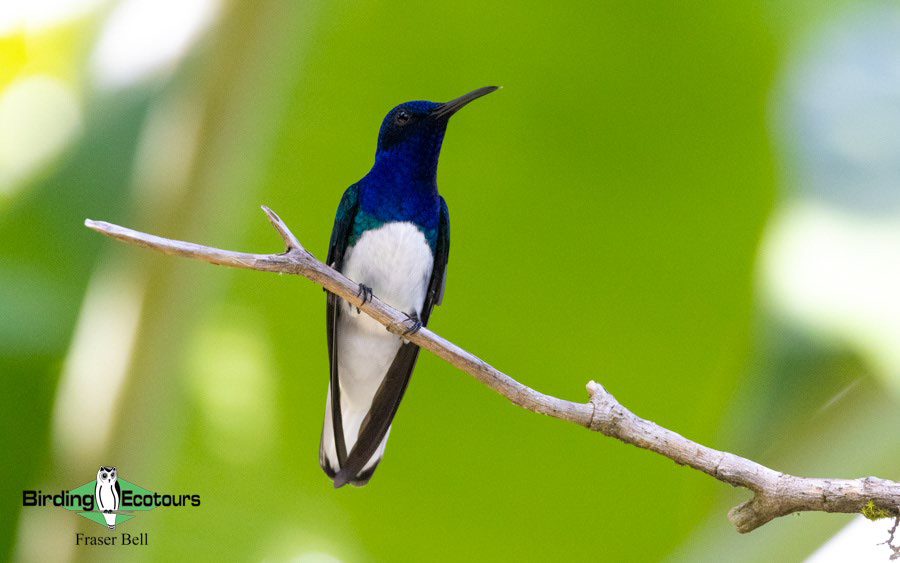
We saw all 12 of Trinidad’s common hummingbirds on the drive to the airport, including this White-necked Jacobin.
Day 12, 9th December 2024. Departure
At first light we had coffee overlooking the Caribbean Sea before heading up the hill for one last forest birding session. Activity was fairly quiet between rain showers, though several Trinidad Piping Guans were present, and although Grey-fronted Dove remained heard only, two Black-tailed Tityras flew into the same tree as the guans and gave great views. We also had an amazing sighting of a Common Lancehead, one of the most venomous snakes in the Americas. It was on the forest floor near the guan viewing platform, giving safe but close views and a reminder of why we avoid walking unmanaged trails during the tour!
After breakfast we travelled back towards Port of Spain, seeing Ringed Kingfishers and Yellow-rumped Caciques. We stopped for lunch at Bajnath’s Estate, a hummingbird garden, where we immediately connected with Ruby-topaz Hummingbirds, a stunning migratory species returning to Trinidad for winter. Over three hours we observed 12 hummingbird species, ate a tasty homemade lunch, with local wine and some sweet treats, before continuing to our airport hotel. The final birding session was at some grassland near the hotel, where we had superb views of a pair of White-headed Marsh Tyrants, and two Ruddy-breasted Seedeaters. The seedeaters were once common in Trinidad, but now rare due to their popularity as caged birds, so it was nice to see two of these birds happily feasting on grass seeds. A brilliant final sighting to close out the trip!
As always, Trinidad and Tobago is a fantastic destination for birdwatchers, and our group had a great time throughout. I’m looking forward to returning soon and hopefully birding with you all again before long!
Bird List – Following IOC (Version 14.2 / August 2024)
All species were seen, aside from the birds marked with (H) after the common name, which were ‘heard only’.
The following notation after species names is used to show conservation status following BirdLife International: EN = Endangered, VU = Vulnerable. (Endemic) = Trinidad and Tobago endemic birds.
| Common Name | Scientific Name |
| Tinamous (Tinamidae) | |
| Little Tinamou (H) | Crypturellus soui |
| Ducks, Geese, Swans (Anatidae) | |
| Black-bellied Whistling Duck | Dendrocygna autumnalis |
| Blue-winged Teal | Spatula discors |
| America Wigeon | Mareca americana |
| White-cheeked Pintail | Anas bahamensis |
| Ring-necked Duck | Aythya collaris |
| Lesser Scaup | Aythya affinis |
| Guans, Chachalacas, and Curassows (Cracidae) | |
| Rufous-vented Chachalaca | Ortalis ruficauda |
| Trinidad Piping Guan (Endemic) CR | Pipile pipile |
| Flamingos (Phoenicopteridae) | |
| American Flamingo | Phoenicopterus ruber |
| Grebes (Podicipedidae) | |
| Least Grebe | Tachybaptus dominicus |
| Pied-billed Grebe | Podilymbus podiceps |
| Pigeons and Doves (Columbidae) | |
| Rock Pigeon | Columba livia |
| Pale-vented Pigeon | Patagioenas cayennensis |
| Scaled Pigeon | Patagioenas speciosa |
| Ruddy Ground Dove | Columbina talpacoti |
| White-tipped Dove | Leptotila verreauxi |
| Grey-fronted Dove (H) | Leptotila rufaxilla |
| Eared Dove | Zenaida auriculata |
| Cuckoos (Cuculidae) | |
| Greater Ani | Crotophaga major |
| Smooth-billed Ani | Crotophaga ani |
| Striped Cuckoo | Tapera naevia |
| Squirrel Cuckoo | Piaya cayana |
| Mangrove Cuckoo | Coccyzus minor |
| Nightjars and Allies (Caprimulgidae) | |
| Pauraque | Nyctidromus albicollis |
| Short-tailed Nighthawk | Lurocalis semitorquatus |
| Potoos (Nyctibiidae) | |
| Common Potoo | Nyctibius griseus |
| Oilbird (Steatornithidae) | |
| Oilbird | Steatornis caripensis |
| Swifts (Apodidae) | |
| Chestnut-collared Swift | Streptoprocne rutila |
| Gray-rumped Swift | Chaetura cinereiventris |
| Short-tailed Swift | Chaetura brachyura |
| Fork-tailed Palm Swift | Tachornis squamata |
| Hummingbirds (Trochilidae) | |
| White-necked Jacobin | Florisuga mellivora |
| Rufous-breasted Hermit | Glaucis hirsutus |
| Green Hermit | Phaethornis guy |
| Little Hermit | Phaethornis longuemareus |
| Brown Violetear | Colibri delphinae |
| Ruby-topaz Hummingbird | Chrysolampis mosquitus |
| Black-throated Mango | Anthracothorax nigricollis |
| Green-throated Mango | Anthracothorax viridigula |
| Tufted Coquette | Lophornis ornatus |
| Long-billed Starthroat | Heliomaster longirostris |
| White-tailed Sabrewing | Campylopterus ensipennis |
| Copper-rumped Hummingbird | Saucerottia tobaci |
| White-chested Emerald | Chrysuronia brevirostris |
| Blue-chinned Sapphire | Chlorestes notata |
| Rails, Gallinules, and Coots (Rallidae) | |
| Gray-cowled Wood Rail | Aramides cajaneus |
| Common Gallinule | Gallinula galeata |
| Purple Gallinule | Porphyrio martinica |
| Stilts and Avocets (Recurvirostridae) | |
| Black-necked Stilt | Himantopus mexicanus |
| Plovers and Lapwings (Charadriidae) | |
| Southern Lapwing | Vanellus chilensis |
| Semipalmated Plover | Charadrius semipalmatus |
| Jacanas (Jacanidae) | |
| Wattled Jacana | Jacana jacana |
| Sandpipers and Allies (Scolopacidae) | |
| Hudsonian Whimbrel | Numenius hudsonicus |
| Short-billed Dowitcher (VU) | Limnodromus griseus |
| Spotted Sandpiper | Actitis macularius |
| Solitary Sandpiper | Tringa solitaria |
| Lesser Yellowlegs (VU) | Tringa flavipes |
| Greater Yellowlegs | Tringa melanoleuca |
| Ruddy Turnstone | Arenaria interpres |
| Least Sandpiper | Calidris minutilla |
| Gulls, Terns, and Skimmers (Laridae) | |
| Laughing Gull | Leucophaeus atricilla |
| Common Tern | Sterna hirundo |
| Royal Tern | Thalasseus maximus |
| Tropicbirds (Phaethontidae) | |
| Red-billed Tropicbird | Phaethon aethereus |
| Frigatebirds (Fregatidae) | |
| Magnificent Frigatebird | Fregata magnificens |
| Boobies and Gannets (Sulidae) | |
| Brown Booby | Sula leucogaster |
| Red-footed Booby | Sula sula |
| Anhingas (Anhingidae) | |
| Anhinga | Anhinga anhinga |
| Cormorants and Shags (Phalacrocoracidae) | |
| Neotropic Cormorant | Nannopterum brasilianum |
| Pelicans (Pelecanidae) | |
| Brown Pelican | Pelecanus occidentalis |
| Herons, Egrets, and Bitterns (Ardeidae) | |
| Great Blue Heron | Ardea herodias |
| Great Egret | Ardea alba |
| Snowy Egret | Egretta thula |
| Little Blue Heron | Egretta caerulea |
| Tricolored Heron | Egretta tricolor |
| Western Cattle Egret | Ardea ibis |
| Green Heron | Butorides virescens |
| Striated Heron | Butorides striata |
| Black-crowned Night Heron | Nycticorax nycticorax |
| Yellow-crowned Night Heron | Nyctanassa violacea |
| Ibises and Spoonbills (Threskiornithidae) | |
| Scarlet Ibis | Eudocimus ruber |
| New World Vultures (Cathartidae) | |
| Black Vulture | Coragyps atratus |
| Turkey Vulture | Cathartes aura |
| Osprey (Pandionidae) | |
| Osprey | Pandion haliaetus |
| Hawks, Eagles, and Kites (Accipitridae) | |
| Gray-headed Kite | Leptodon cayanensis |
| Snail Kite | Rostrhamus sociabilis |
| Black Hawk-Eagle | Elanoides forficatus |
| Ornate Hawk-Eagle | Spizaetus tyrannus |
| Long-winged Harrier | Circus buffoni |
| Common Black Hawk | Buteogallus anthracinus |
| Rufous Crab Hawk | Buteogallus aequinoctialis |
| Savanna Hawk | Buteogallus meridionalis |
| Great Black Hawk | Buteogallus urubitinga |
| White Hawk | Pseudastur albicollis |
| Grey-lined Hawk | Buteo nitidus |
| Short-tailed Hawk | Buteo brachyurus |
| Zone-tailed Hawk | Buteo albonotatus |
| Owls (Strigidae) | |
| Tropical Screech Owl | Megascops choliba |
| Ferruginous Pygmy Owl | Glaucidium brasilianum |
| Trogons (Trogonidae) | |
| Green-backed Trogon | Trogon viridis |
| Guianan Trogon | Trogon violaceus |
| Collared Trogon | Trogon collaris |
| Motmots (Momotidae) | |
| Trinidad Motmot (Endemic) | Momotus bahamensis |
| Kingfishers (Alcedinidae) | |
| Ringed Kingfisher | Megaceryle torquata |
| Belted Kingfisher | Megaceryle alcyon |
| American Pygmy Kingfisher | Chloroceryle aenea |
| Jacamars (Galbulidae) | |
| Rufous-tailed Jacamar | Galbula ruficauda |
| Toucans (Ramphastidae) | |
| Channel-billed Toucan | Ramphastos vitellinus |
| Woodpeckers (Picidae) | |
| Red-crowned Woodpecker | Melanerpes rubricapillus |
| Red-rumped Woodpecker | Veniliornis kirkii |
| Crimson-crested Woodpecker | Campephilus melanoleucos |
| Lineated Woodpecker | Dryocopus lineatus |
| Golden-olive Woodpecker | Colaptes rubiginosus |
| Falcons and Caracaras (Falconidae) | |
| Crested Caracara | Caracara plancus |
| Yellow-headed Caracara | Daptrius chimachima |
| Merlin | Falco columbarius |
| Peregrine Falcon | Falco peregrinus |
| New World and African Parrots (Psittacidae) | |
| Lilac-tailed Parrotlet | Touit batavicus |
| Blue-headed Parrot | Pionus menstruus |
| Orange-winged Amazon | Amazona amazonica |
| Green-rumped Parrotlet | Forpus passerinus |
| Blue-and-yellow Macaw | Ara ararauna |
| Typical Antbirds (Thamnophilidae) | |
| Great Antshrike | Taraba major |
| Black-crested Antshrike | Sakesphorus canadensis |
| Barred Antshrike | Thamnophilus doliatus |
| Plain Antvireo | Dysithamnus mentalis |
| White-flanked Antwren | Myrmotherula axillaris |
| Northern White-fringed Antwren | Formicivora intermedia |
| Silvered Antbird | Sclateria naevia |
| White-bellied Antbird | Myrmeciza longipes |
| Ovenbirds and Woodcreepers (Furnariidae) | |
| Grey-throated Leaftosser | Sclerurus albigularis |
| Olivaceous Woodcreeper | Sittasomus griseicapillus |
| Plain-brown Woodcreeper | Dendrocincla fuliginosa |
| Cocoa Woodcreeper | Xiphorhynchus susurrans |
| Straight-billed Woodcreeper | Dendroplex picus |
| Yellow-chinned Spinetail | Certhiaxis cinnamomeus |
| Pale-breasted Spinetail | Synallaxis albescens |
| Stripe-breasted Spinetail | Synallaxis cinnamomea |
| Manakins (Pipridae) | |
| Blue-backed Manakin | Chiroxiphia pareola |
| White-bearded Manakin | Manacus manacus |
| Golden-headed Manakin | Ceratopipra erythrocephala |
| Cotingas (Cotingidae) | |
| Bearded Bellbird | Procnias averano |
| Tityras and Allies (Tityridae) | |
| Black-tailed Tityra | Tityra cayana |
| White-winged Becard | Pachyramphus polychopterus |
| Tyrant Flycatchers (Tyrannidae) | |
| White-throated Spadebill | Platyrinchus mystaceus |
| Ochre-bellied Flycatcher | Mionectes oleagineus |
| Yellow-olive Flatbill | Tolmomyias sulphurescens |
| Ochre-lored Flatbill | Tolmomyias flaviventris |
| Southern Beardless Tyrannulet | Camptostoma obsoletum |
| Forest Elaenia | Myiopagis gaimardii |
| Yellow-bellied Elaenia | Elaenia flavogaster |
| Bran-colored Flycatcher | Myiophobus fasciatus |
| Euler’s Flycatcher | Lathrotriccus euleri |
| Olive-sided Flycatcher | Contopus cooperi |
| Northern Tropical Pewee | Contopus bogotensis |
| Fuscous Flycatcher | Cnemotriccus fuscatus |
| Northern Scrub Flycatcher | Sublegatus arenarum |
| White-headed Marsh Tyrant | Arundinicola leucocephala |
| Pied Water Tyrant | Fluvicola pica |
| Venezuelan Flycatcher (H) | Myiarchus venezuelensis |
| Brown-crested Flycatcher | Myiarchus tyrannulus |
| Great Kiskadee | Pitangus sulphuratus |
| Boat-billed Flycatcher | Megarynchus pitangua |
| Variegated Flycatcher | Empidonomus varius |
| Tropical Kingbird | Tyrannus melancholicus |
| Grey Kingbird | Tyrannus dominicensis |
| Fork-tailed Flycatcher | Tyrannus savana |
| Bright-rumped Attila (H) | Attila spadiceus |
| Vireos, Shrike-Babblers, and Erpornis (Vireonidae) | |
| Rufous-browed Peppershrike | Cyclarhis gujanensis |
| Scrub Greenlet | Hylophilus flavipes |
| Golden-fronted Greenlet | Pachysylvia aurantiifrons |
| Chivi Vireo | Vireo chivi |
| Swallows (Hirundinidae) | |
| Southern Rough-winged Swallow | Stelgidopteryx ruficollis |
| Grey-breasted Martin | Progne chalybea |
| White-winged Swallow | Tachycineta albiventer |
| Sand Martin | Riparia riparia |
| Barn Swallow | Hirundo rustica |
| American Cliff Swallow | Petrochelidon pyrrhonota |
| Gnatcatchers (Polioptilidae) | |
| Trilling Gnatwren | Ramphocaenus melanurus |
| Wrens (Troglodytidae) | |
| House Wren | Troglodytes musculus |
| Rufous-breasted Wren | Pheugopedius rutilus |
| Mockingbirds and Thrashers (Mimidae) | |
| Tropical Mockingbird | Mimus gilvus |
| Thrushes and Allies (Turdidae) | |
| Cocoa Thrush | Turdus fumigatus |
| Yellow-legged Thrush | Turdus flavipes |
| White-necked Thrush | Turdus albicollis |
| Spectacled Thrush | Turdus nudigenis |
| Waxbills and Allies (Estrildidae) | |
| Tricolored Munia | Lonchura malacca |
| Finches, Euphonias, and Allies (Fringillidae) | |
| Trinidad Euphonia | Euphonia trinitatis |
| Violaceous Euphonia | Euphonia violacea |
| Troupials and Allies (Icteridae) | |
| Red-breasted Meadowlark | Leistes militaris |
| Crested Oropendola | Psarocolius decumanus |
| Yellow-rumped Cacique | Cacicus cela |
| Yellow Oriole | Icterus nigrogularis |
| Giant Cowbird | Molothrus oryzivorus |
| Carib Grackle | Quiscalus lugubris |
| Yellow-hooded Blackbird | Chrysomus icterocephalus |
| New World Warblers (Parulidae) | |
| Northern Waterthrush | Parkesia noveboracensis |
| Masked Yellowthroat | Geothlypis aequinoctialis |
| American Redstart | Setophaga ruticilla |
| Tropical Parula | Setophaga pitiayumi |
| American Yellow Warbler | Setophaga aestiva |
| Golden-crowned Warbler | Basileuterus culicivorus |
| Cardinals and Allies (Cardinalidae) | |
| Summer Tanager | Piranga rubra |
| Red-crowned Ant Tanager | Habia rubica |
| Tanagers and Allies (Thraupidae) | |
| Masked Cardinal | Paroaria nigrogenis |
| White-shouldered Tanager | Loriotus luctuosus |
| White-lined Tanager | Tachyphonus rufus |
| Silver-beaked Tanager | Ramphocelus carbo |
| Blue-gray Tanager | Thraupis episcopus |
| Palm Tanager | Thraupis palmarum |
| Turquoise Tanager | Tangara mexicana |
| Bay-headed Tanager | Tangara gyrola |
| Blue Dacnis | Dacnis cayana |
| Purple Honeycreeper | Cyanerpes caeruleus |
| Green Honeycreeper | Chlorophanes spiza |
| Bicolored Conebill | Conirostrum bicolor |
| Saffron Finch | Sicalis flaveola |
| Blue-black Grassquit | Volatinia jacarina |
| Ruddy-breasted Seedeater | Sporophila minuta |
| Bananaquit | Coereba flaveola |
| Black-faced Grassquit | Melanospiza bicolor |
| Olive-grey Saltator | Saltator olivascens |
| Total seen | 218 |
| Total heard only | 4 |
| Total recorded | 222 |
Mammal List – Following Mammalwatching.com (September 2024)
| Common Name | Scientific Name |
| Agouti and Acouchis (Dasyproctidae) | |
| Common Red-rumped Agouti | Dasyprocta leporina |
| Squirrels (Sciuridae) | |
| Red-tailed squirrel | Sciurus granatensis |
| Bulldog or Fishing Bats (Noctilionidae) | |
| Greater Bulldog Bat | Noctilio leporinus |
| Sac-winged Bats (Emballonuridae) | |
| Greater Sac-winged Bat | Saccopteryx bilineata |
| New World Leaf-nosed Bats (Chiroptera) | |
| Greater Spear-nosed Bat | Phyllostomus hastatus |
| Mongooses (Herpestidae) | |
| Small Indian Mongoose | Urva auropunctata |
| Total | 6 |
Reptile and Amphibian List – Following IUCN
Red List (April 2025)
| Common Name | Scientific Name |
| Freshwater Turtles (Emydidae) | |
| Spot-legged Wood Turtle | Rhinoclemmys punctularia |
| Alligators and Caimans (Alligatoridae) | |
| Spectacled Caimen | Caiman crocodilus |
| Anoles (Dactyloidae) | |
| Grenada Bush Anole | Anolis aeneus |
| Common Geckos (Gekkonidae) | |
| Common Tropical House Gecko | Hemidactylus mabouia |
| Dwarf Geckos (Sphaerodactylidae) | |
| Eyespot Gecko (Endemic) | Gonatodes ocellatus |
| Whiptails (Teiidae) | |
| Giant Ameiva | Ameiva ameiva |
| Amazon Racerunner | Ameiva atrigularis |
| Black Tegu | Tupinambis teguixin |
| Tropical Ground Lizards (Tropiduridae) | |
| Tree Runner | Plica caribeana |
| Colubrid Snakes (Colubridae) | |
| Parrot Snake | Leptophis ahaetulla |
| Cloudy Snail-eating Snake | Sibon nebulatus |
| Boas (Boidae) | |
| Ruschenberger’s Tree Boa | Corallus ruschenbergerii |
| Vipers (Viperidae) | |
| Common Lancehead | Bothrops atrox |
| True Toads (Bufonidae) | |
| South American Cane Toad | Rhinella marina |
| Tree Frogs (Hylidae) | |
| Rusty Treefrog | Boana boans |
| Total | 14 |
DOWNLOAD TRIP REPORT
This is a sample trip report. Please email us ([email protected]) for more trip reports from this destination.
TRINIDAD AND TOBAGO GENERAL INFORMATION
GENERAL INFORMATION
On this Trinidad and Tobago birding adventure we explore the twin islands of Trinidad and Tobago, allowing ample time to appreciate their distinct characters, and diverse habitats. Our trip starts on beautiful Tobago, where we will enjoy a tranquil and Caribbean approach to our birding. We explore coastal wetlands of southern Tobago, embark on a glass-bottom boat trip to the Little Tobago Island seabird colony, and target impressive localized species like White-tailed Sabrewing on the main forested ridge. On the larger, vibrant Trinidad, we use the famous Asa Wright Nature Centre as our base. From here we delve into coastal wetlands, mangroves, and marshes on both the east and west coasts, the tropical savanna and scrub of central Trinidad, and the lush forests of the northern range. Towards the end of our stay in Trinidad, we travel to the remote northwest, in search of the Trinidad Piping Guan, a shy species restricted to these hill forests. The diversity of birds we encounter during this tour will be impressive, and we should have a lot of opportunity for photography and close views of brilliantly colorful species. This trip features unforgettable birding in a true tropical paradise.
WEATHER
Nestled in the southern Caribbean near the equator, Trinidad and Tobago have a constant temperate tropical climate year-round. The islands are influenced by both the warm Caribbean and Northeast Trade Winds, which together prevent extreme heat and temperature fluctuations, giving the twin islands a relatively constant temperature. The climate alternates between wet and dry seasons. The wet season, from June to November, features periods of heavy rainfall, occasional thunderstorms, and high humidity. Hurricanes are most likely between August and October, with Tobago at a higher risk due to its northern location. In contrast, the dry season spans January to April, offering warm days and cool nights with little rainfall. May and December are transition months between these seasons. The coolest months are January and February when the average minimum temperature is around 68oF (20oC), while the warmest months are April and October with a maximum average temperature around 89oF (32oC).
On this trip, we visit during the transition from the wet to the dry season, so we expect moderately high daytime temperatures around 84oF (29oC) and pleasant sea temperatures near 82oF (28oC). Night-time temperatures drop to 71oF (22oC). Intermittent afternoon showers are common, typically these are short, but prolonged heavy rain is expected on a couple of afternoons. Please be prepared for all weather, but expect a combination of heat, followed by the occasional heavy downpour to be the main challenge. To combat the weather, we’ll typically start early, and often bird into the early afternoon (dependent on temperature), with a more relaxing schedule planned for the afternoon.
POTENTIAL HAZARDS
Crime
While the people of Trinidad and Tobago are incredibly friendly and welcoming, the risk of crime for travelers has increased in recent years. International visitors have been targeted at popular tourist sites such as waterfalls, beaches, and monuments near urban areas like Port of Spain, particularly in the evening or at night. However, during the tour, we avoid high-crime areas and primarily stay and bird on private land or in remote locations far from where crime is mostly reported. We will always be accompanied by a local guide when outside accommodation grounds, using trusted transfer services. All evening and nocturnal activities are within the accommodation grounds, which are situated in beautifully remote locations with security on-site. We maintain constant contact with local guides and accommodation providers, who have reported no issues at the sites we visit.
In light of the increased risk of crime in 2024, we have made slight adjustments to the itinerary to further minimize any risk. We will not visit a few wetlands in western Trinidad and no longer have lunches at local restaurants, as these activities would involve visiting towns. Instead, we will spend more time birding in eastern Trinidad and enjoy picnic lunches in safer, well-known locations. While the risk remains low, we urge you to be mindful that crime is a possibility throughout the trip. Please take extra care of your personal belongings, and ensure no valuables are left visible in the vehicle when unattended.
Additionally, we advise you:
- Do not visit the capital Port of Spain before or after the tour, the airport is about 30km east of the capital and we do not visit Port of Spain during the tour.
- Be increasingly cautious whilst traveling after dark before and after the tour starts.
- Avoid lone traveling.
- Do not use public transport, book private transfers in advance and do not use local unmarked cars as a taxi.
- Be extra vigilant when visiting ATMs.
Dangerous animals
While Trinidad only has few species of venomous snakes, we will be visiting areas inhabited by these snakes, and as usual, we will be very lucky to see any. We recommend hiking boots, jeans/long trousers, and a good dose of care to minimize the danger of snakebites. We do not take anti-venom on our tours but will try and rush you to a private hospital if you do get bitten (although we will often be in remote places); your own travel insurance (especially medical insurance) is crucial. Scorpions and spiders can cause problems, but there are no large terrestrial mammals on either island to worry about.
Diseases
Malaria is not present in Trinidad and Tobago, however, Dengue fever and other insect-borne diseases, although uncommon, are present and so we recommend taking personal protective measures. These include using mosquito repellent, wearing long pants, and long-sleeved shirts, particularly at night when mosquitos and other biting insects are active.
Please carefully read the CDC traveler advice here which contains information on required vaccinations to enter Trinidad and Tobago.
ELECTRICITY
Electricity is 115 V with the standard type A and type B electrical sockets (both have two flat parallel pins; type B has a grounding pin, see here for pictures). Although the electrical sockets are the same as in North America, not all sockets in Trinidad and Tobago will be polarized (i.e. they are commonly type A) so you may still need an international adapter to use your plug, if you intend to recharge electrical devices, video batteries etc. in your room.
SOME THINGS WE RECOMMEND YOU BRING
Clothing specific to this tour
In Trinidad and Tobago, we expect the weather to be warm to hot during the day, so hot weather clothes are recommended. The weather is often mild at night, and during our excursion to higher altitude temperatures may drop, so we recommend bringing long pants and sweaters. Our boat trip into the dense mangrove forest of the Caroni Marsh will likely have biting insects, so long sleeves and long pants are advised. This tour is run at the best time for birds, but the disadvantage is the intermittent afternoon rain which can be heavy, so waterproofs are important. During the tour we visit and stay near several beaches, where comfortable light clothing would be suitable. There will be opportunity to swim during the tour.
Equipment specific to this tour
Good rain gear is essential, with a lightweight waterproof, such as a poncho, being particularly useful as we may encounter heavy downpours while out on the trails. If you’re unsteady on your feet, a hiking pole or walking stick could be helpful, especially on uneven and steep sections of trails, such as those at Asa Wright and the Main Ridge in Tobago. Lightweight hiking boots are the best footwear for this tour with much of the birding along roads rather than long hikes through the forest. Sandals (flip-flops) or trainers are useful for walking around the accommodations but are not suitable for birding (consider snake bites, mud, slips, and falls). The boat crossing to Little Tobago Island is typically calm, but weather conditions can sometimes make the waters rougher. If you’re prone to motion sickness, you may need to take medication for this trip.
General list for all tours
Please note that space in the vehicle may be limited, but we understand that birders do need lots of equipment! There will be opportunities for laundry.
- Binoculars (the guides cannot lend theirs)
- A spotting scope and tripod (although our leader will have a spotting scope)
- Field guides (see below recommendations)
- Any other birding equipment
- Photographic equipment
- Spare batteries for photographic and other gear
- Flashlight/torch/headlamp with spare batteries
- Toiletries
- Personal medication. We recommend packing important medication (and a change of clothes) in your hand luggage in the unlikely event of lost luggage.
- Some countries might require a valid Yellow Fever Certificate (Trinidad requires this if you are traveling from a region where Yellow Fever is present), and we advise visiting a travel clinic or your family doctor and visiting the Centers for Disease Control website for health advice.
- Rain gear (we expect to have rain on this trip, typically heavy short showers in the afternoons)
- Passport and if required, visas, copies of passport, medical insurance policies, and other important documents, which can be left with the Birding Ecotours office.
- Money for drinks, gifts, tips (although tips at restaurants during the tour are included), items of a personal nature, etc.
- Traveler’s checks are often difficult to use, except in the USA, but Visa and Mastercard are widely accepted, including for drawing local currency at ATMs.
- Hiking boots plus another pair of shoes and sandals
- Swimming gear
- Cap/hat and sunglasses
- Sunscreen and lip sun protection
- Mosquito repellent
- Long-sleeved clothes as a precaution against biting insects
BIRDING ECOTOURS EMERGENCY CONTACT DETAILS
Office: Nadia +27-72-211-9863, Chris +44-7808-571-444
E-mail: [email protected] (which is checked almost daily)
FIELD GUIDES
Birds
Field Guide of the Birds of Trinidad and Tobago by Martyn Kenefick, Robin Restall and Floyd Hayes (3rd Ed), 2019 – The best available bird guide.
A guide to the Birds of Trinidad and Tobago by Richard Ffrench (3rd Ed), 2003 – A great guide but outdated and less useful in the field compared to Kenefick et al.
Mammals
Trinidad and Tobago: Wildlife guide by Rainforest Publications, 2012, – a laminated fold out guide of the most frequently encountered mammals, birds, reptiles, amphibians, and invertebrates on the islands. Only shows commonly encountered species but does cover most of the mammals we’ll likely see.
Reptiles and Amphibians
A field guide to the Amphibians and Reptiles of Trinidad and Tobago by the Field Naturalist Club, 2018 – Well reviewed.
Butterflies
Trinidad and Tobago Butterflies by Rainforest Publications, 2015. A laminated fold out guide of the most often encountered species on the islands – Not comprehensive.
This is the most comprehensive tour of Trinidad and Tobago you will find. We got to experience different habitats and saw so many birds and different kinds of wildlife. The evening trip to Caroni Swamp for the roosting of the Scarlet Ibis is unforgettable!
We really enjoyed this tour, and it is one of our favorite tours to date. Fraser Bell was an excellent guide as was the local guide Lester on Trinidad. Both Asa Wright center locations on Trinidad were perfect for us, and we give it 5 stars out of 5. The accommodations, food, and guiding staff were top notch. We highly recommend this place for your future tour guests.
